

Empire Mine State Historic Park
Current restrictions.
Last Checked: 5/3/2024 11:54 PM
The Park is currently OPEN .
- Reservations
Passes Information
- Upcoming Events
Contact Number
- (530) 273-8522
Park Accessibility Information
- View the Park Accessibility Information
Historic Grounds are open daily.
Winter hours (Nov. 1 - Feb 28): 10AM - 4PM
Summer hours (Mar 1 - Oct 31): 10:00 AM - 5:00 PM
The grounds are closed Thanksgiving Day, Christmas Day, & New Years Day.
Park trails and the Penn Gate parking lot are open from sunrise to sunset.

Park Activities
Park facilities.
- Park Brochure
Park Directions
Get directions through Google Maps
Drive 24 miles north of Auburn on Highway 49 to Empire Street exit in Grass Valley. The park is located in Grass Valley at 10791 East Empire Street.
Visit Empire Mine!
Empire Mine State Historic Park is the site of one of the oldest, deepest, and richest gold mines in California. The park is in Grass Valley at 10791 East Empire Street. In operation for more than 100 years, the mine extracted 5.8 million ounces of gold before it closed in 1956. The park contains many of the mine’s buildings, the owner’s home and restored gardens, as well as the entrance to 367 miles of abandoned and flooded mine shafts. The park encompasses 856 acres of forested backcountry and fourteen miles of trails - including easy hikes (for hiking, mountain biking and horseback riding) - in the park.
The "Secret Room"
To keep track of the mine's 367 underground workings, a place called "The Secret Room" (named for its blacked-out windows) was built. In it, the entire room was filled with a scale model of the mine's below the surface workings. Few people knew the room existed while the mine was in operation. Today, visitors to the park can see it in the Visitor Center. The model represents five square miles of underground workings. When the visitors go down the actual shaft in the park, they have journeyed only "one inch" on the model. Anything past "two inches" on the model is underwater in the actual mine.
Come along on a Park Tour!
Take a 45-minute guided tour to see highlights of our historic park. Tours are first come first served; sign up at the Visitor Center when you arrive (no advance reservations).
Weather can be unpredicable in any season, so please wear weather-appropriate clothing, and be aware that inclement weather may cancel. Tours are lead by our knowledgeable volunteers; some tour shifts may not be filled due to staffing vacancy, please call the vistor center to confirm that your tour of interest is scheduled.
Estate Tours :
This tour allows you to get a special peek inside the life and home of the owner of the mine. Step into the historic cottage and learn about the beautiful estate within the hardrock mine property.
November-April: 11 a.m. Daily, 1:00 p.m. Friday-Sunday
May - October: 11:30 Daily, 1:30 p.m. Friday-Sunday
Mineyard Tours :
This tour takes you through the equipment and hard work needed for the profitable Empire mine to run. Afterwards is a great time to stop by the blacksmith shop and see our craftsmen at work. Hot weather may cancel; if temperatures are over 90 degrees, this tour will become a second Estate Tour and the blacksmith shop may close early.
November - April: 12:00 p.m. Daily, 2:00 p.m. Friday-Sunday
May - October: 12:30 a.m. Daily, 2:30 p.m. Friday-Sunday
Garden Tours :
See highlights of the beautifully landscaped historic gardens. Tour guides will enlighten you to the unique vintage varieties of roses and other botanicals.
May - October: Wednesdays and Saturdays, 10:15 a.m.
*Tours may cancel due to weather; call the Visitor Center for details to plan your visit.
Filming Videos and Still Photography in State Parks

- All commercial still photography and videography
- Professional photographers offering services
- Student photo/film projects
- Professional development projects
Land Acknowledgement
California State Parks acknowledges the Nisenan People were here in this State Park since time immemorial. The Nisenan People are still here today, though they are nearly invisible.
The Sierra District of California State Parks includes their story in our interpretation and education here at the Empire Mine State Historic Park. We understand we are on Nisenan Land and that the original Tribal Families have yet to recover from the near genocide of their people during the California Gold Rush.
California State Parks supports the Nevada City Rancheria Tribe in efforts to stabilize their people as well as the campaign to restore Tribal sovereignty through Federal Recognition.
Location-Directions

Image Gallery
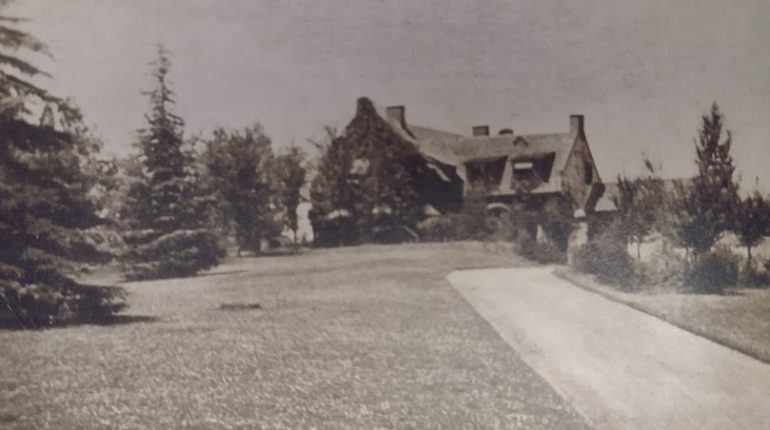
Visit The Historic Empire Mine State Park
Want To Share This?
Located in the beautiful Sierra Nevada foothills in the historic town of Grass Valley, the Empire Mine State Historic Park is one of the most well-preserved gold mines in the United States. Sitting on 856 acres, this mine contains 367 miles of mine tunnels and 14 miles of some amazing dog friendly hiking trails.
Though there are many gold mines in Nevada County (some of them are within the Empire Mine State Park grounds), but the Empire Mine is the most well known and best preserved. Locals and tourists alike enjoy the beautifully kept grounds. And on a quick note, it can even be rented for wedding ceremonies.
Weather Forecast For Grass Valley, CA:
Quick Information:
* Address: 10791 East Empire Street Grass Valley, Ca 994 * Phone: (530) 273-8522
* Park Hours: Summer 10am-5pm
Winter 10am-4pm * Established: 1975 * Size: 856 Acres
* Elevation: 2500 - 2900
Day Use Fee: $5 for 6 years and older
Dogs: On Trails Only
Toilets: Yes

A Very Brief History, Gold and the Empire Mine
Back in the year 1850 as the story goes, a gentleman by the name of George McKnight and two associates found rock with gold in it, though this was the 3rd location to find gold in Grass Valley, this was the first one to draw the attention of the placer miners.
It was at that moment the "Gold Rush" began in Grass Valley. This was just 2 years after gold was first discovered by James Marshall in Coloma, California. Known as Placer Mining or mining in stream beds. But this was the first hard rock gold found in California.
In the same area where McKnight first found gold, many a miner dug what was called a "coyote hole", all with the thirst for gold. Because no one had mined for gold like this before, there was a lot of trial and error, and many miners lost everything they had and moved back to placer mining. Though money had been made by some, it wasn't easy, and it cost a lot of money to extract the gold from the quartz.
In 1869 the claim and land had been sold to William Bowers Bourn, Sr.. At that time the Empire really prospered. They held onto the mine until 1929. After that it was sold to the Newmont Mining Corporation, who happens to still own the underground portion of the mine to this day. During its time span, it and was one of the most profitable mines in the state of California and in the United States. It was mined for 24 hours a day, 7 days a week. Operations ceased in 1956.
Empire Mine State Historic Park Map:

NOTE: The Dirty Business;
If you need to use the restroom, there are 2 areas available in this park. One being in the parking lot and the second being some very, very clean portables down below the tennis courts.
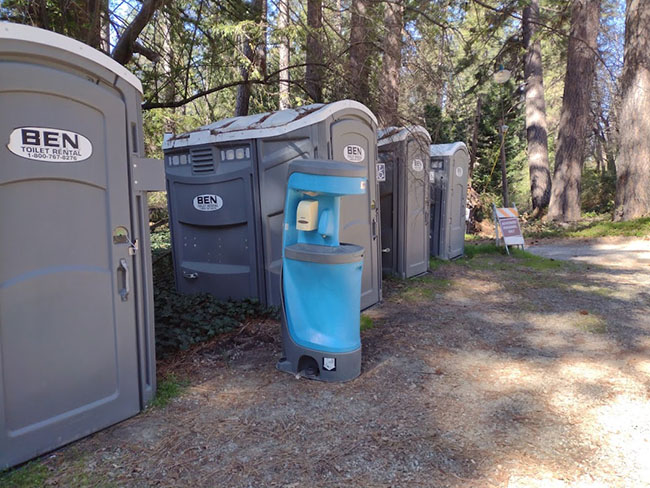
What is there to see at the Empire Mine State Park?
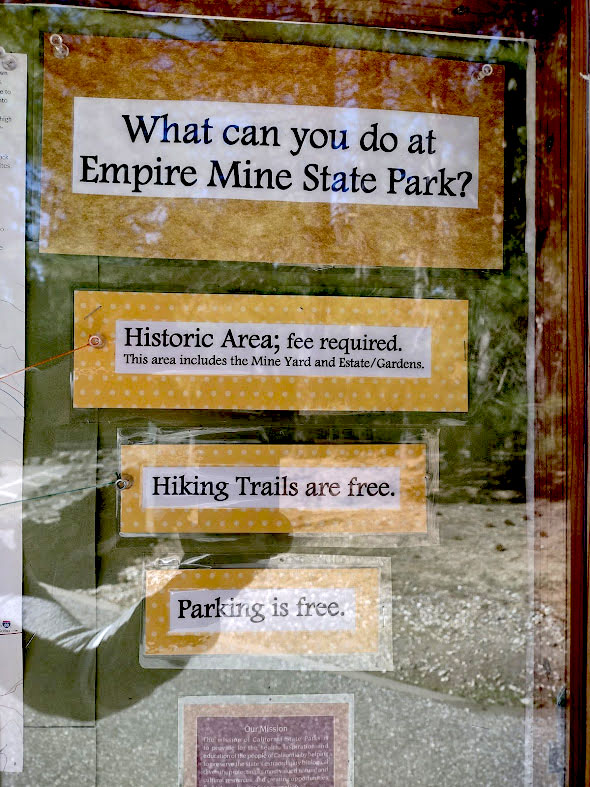
From the pathway in, you are greeted with the Assay office.
Here is where the day's gold was weighed and given a dollar amount. During its time, the Empire Mines assay office would have been an incredibly busy place. When you go inside, you can get a glimpse of what it was like to work inside.
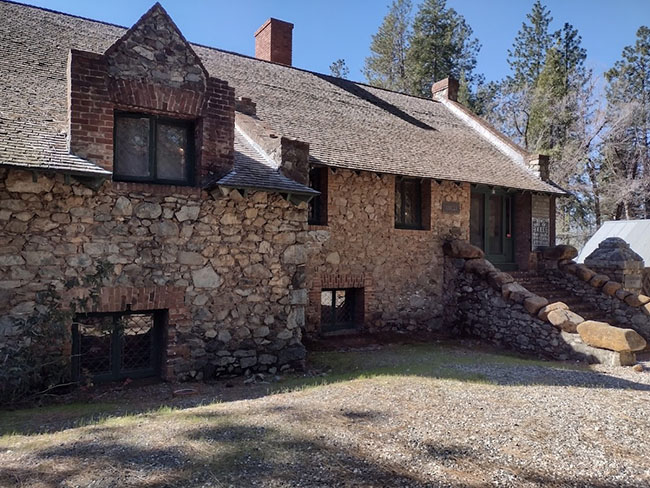
Step Inside and Step Back Into The Past;
Inside the visitor's center you will find terrific information on the Empire Mine's history, its miners and what their life was like for them, the owners of the mine. Plus, you will get an excellent course in history when it comes to the actual mine when you enter the once secret area that holds the scale model of the inner workings of the Empire.
Below are some photos from inside the Visitors Center. The Gold Room holds some incredibly beautiful minerals and some very large pieces of gold.
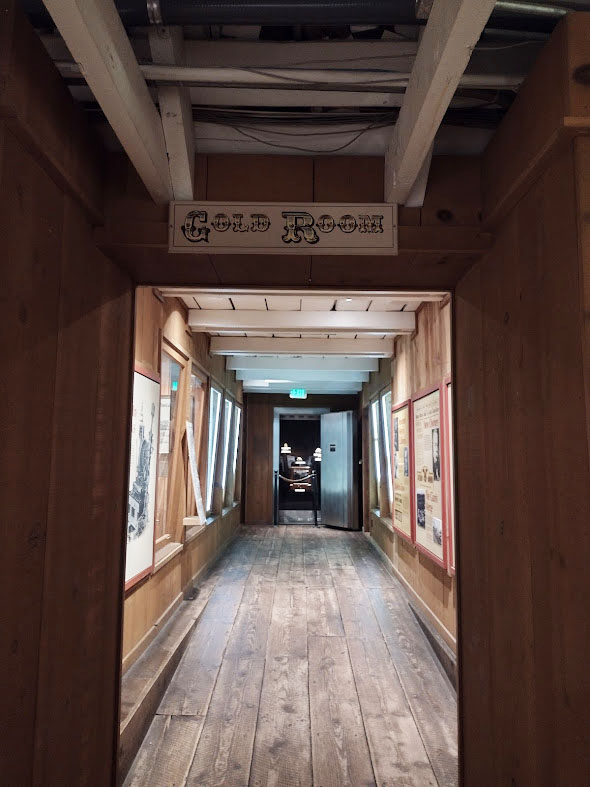
The Bourn Cottage;
This beautiful home has withstood time itself. Though not the largest of the homes owned by the mining moguls, it is the best known. You can step inside with a guided tour to get a real feel for what life would have been like for them when they stayed at the Empire.
Built in 1897, the home had all the amenities afforded to the family, including electricity. Costing $25,000 to build, it would be nearly $1,000,000 with today's inflation. The home was built with mine rock directly from the grounds.
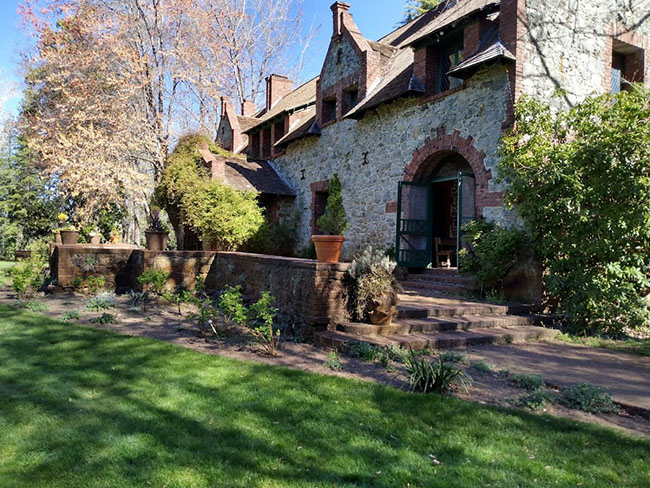
Time to Reflect;
The reflection pool was at one time a place for gatherings. Though it was originally built as a reflecting pool, it was ultimately used for swimming.
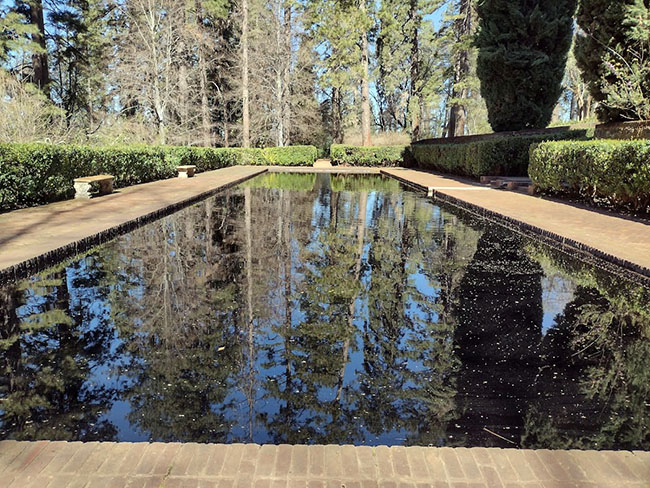
By Invite Only;
To be on the invite list, you would have had to have been in the upper crust of society. By invitation only, you would have enjoyed your stay by playing games, tennis, swimming, strolling the grounds, cocktailing, dancing and eating. But, on that note, the mine just a few hundred yards away ran 24 hours a day for 7 days a week. Miners were not allowed to visit.
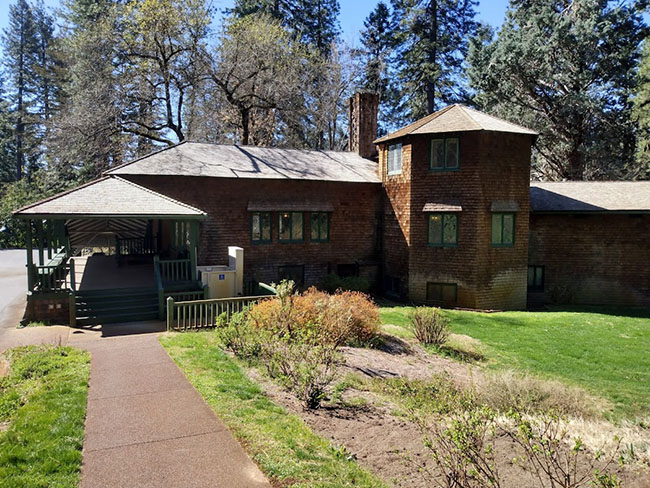
The industrial part of the park;
After passing some relics and ruins, homes of past employees, you enter into the working part of the yard. Smelter, machine shop and smithy. Everything that was needed to produce gold and keep the daily life was contained in this yard.
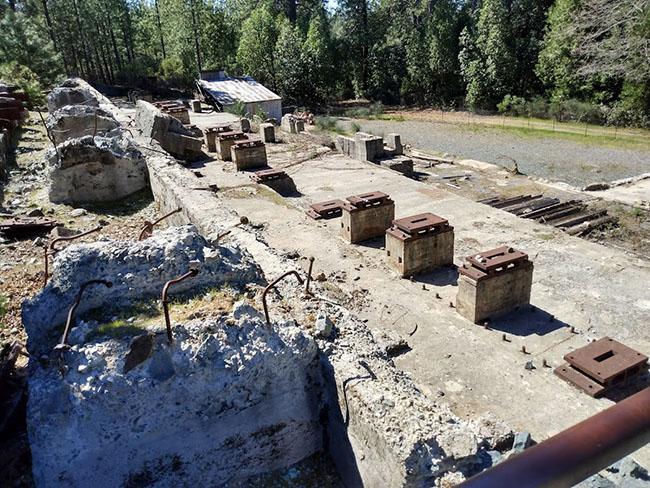
On most days at the Empire Mine State Park, you can find nice fellas like this one below showing their handing work at blacksmithing. He knew a lot about his craft and the historical use of a blacksmith shop at the Empire Mine. Plus, you can buy some handcrafted items made by one of these docents.
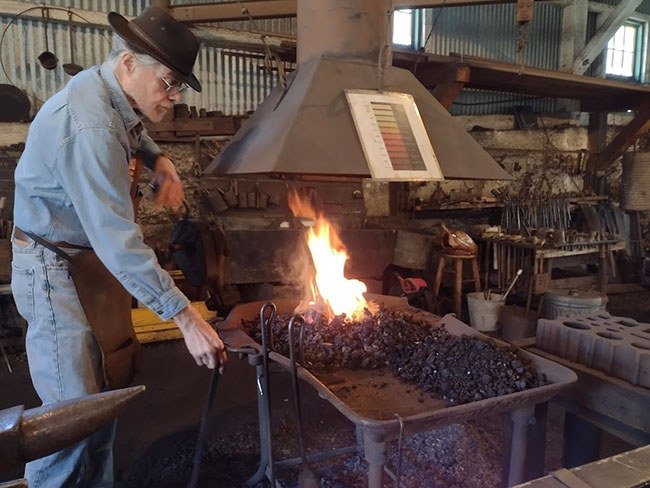
Now for the exciting part;
You can go down into the main shaft at the Empire Mine. It is a very unique experience and definitely a highlight of the tour. It is a pretty steep incline, but there are handrails on both sides. Once in there you can take in but a mere inkling of what these men did every single day.
Traveling on the skip at 6 miles per hour into the darkness. Listen closely, and you can hear a donkey bray, Cornish miners singing and picks chipping away at the earth below you.
If for any reason, you cannot physically go down the stairs into the mine, then you can view it via a window and a mirror to the right of the door. This will allow for a glimpse of the mine.
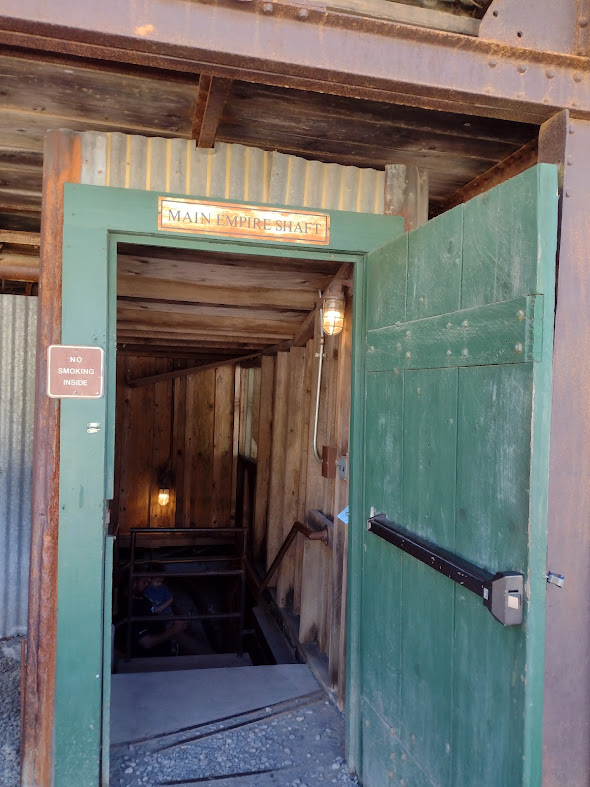
*If your day is just for hiking, then here are a few of the trails available at the mine.*
These trails are free to access and parking is free also., hiking trails at the empire mine.
If your trip to Grass Valley includes your doggo, then this place has trails for you. One of the very few California State Parks that allows dogs on the trails, it can also be used for equestrian riders as well. There is a staging area for horses at the lower "Penn Gate". This is located on Empire Street, about 1/2 mile from the park's main entrance.
Hardrock Trail Loop; 2.4 mile loop
(listed as easy, but i think that should be based on a person to person basis).
This trail is by far the most popular of all the trails, and you will encounter walkers, runners, horses and dogs. It starts out pretty flat but after a small downhill, it goes up for a bit. It will get your heart rate up. Furthermore, it's good for strollers until you get to the creek and head up the gnarly hill towards the main area of the State Park.
If you are sans children, then this one should be a fine workout. It takes you though the parking lot and along the road back towards Penn Gate. It gets very narrow just after you pass the Bourn Cottage along Highway 174.
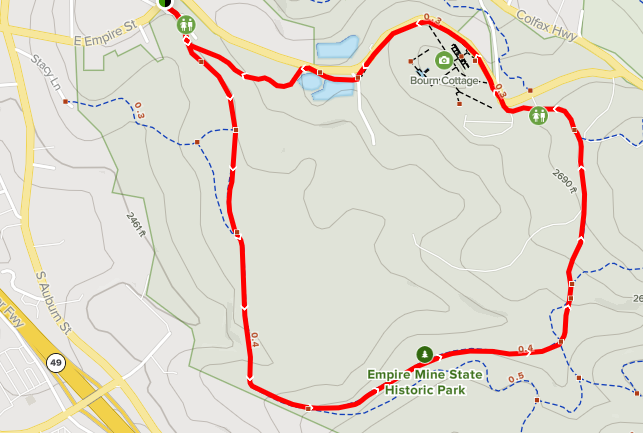
Conlon Mine Loop Trail; 2.8 mile loop
This trail starts out at the visitor center parking lot, heading to your left and going past the mine buildings and machinery. Head down the hill and across the creek. Once there, stay to the left in order to do this trail (if you go to the right, then you will end up at Penn Gate).
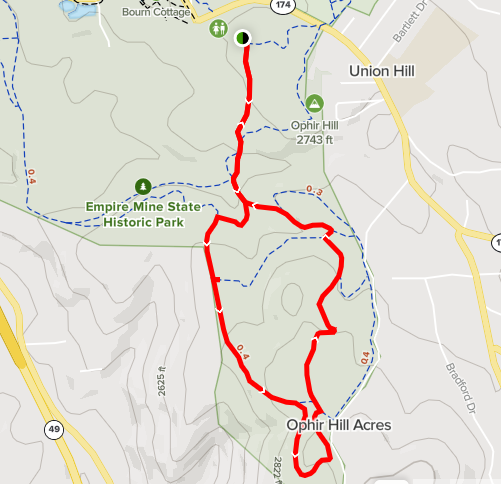
Osborne Hill Loop Trail; 2.4 miles but noted as a moderate hike
This hike is a lot like the Conlon Mine hike, but it takes the outer perimeter, basically paralleling it. However, it omits the area known as Ophir Hill Acres, making this one a bit more difficult but a little shorter in distance.
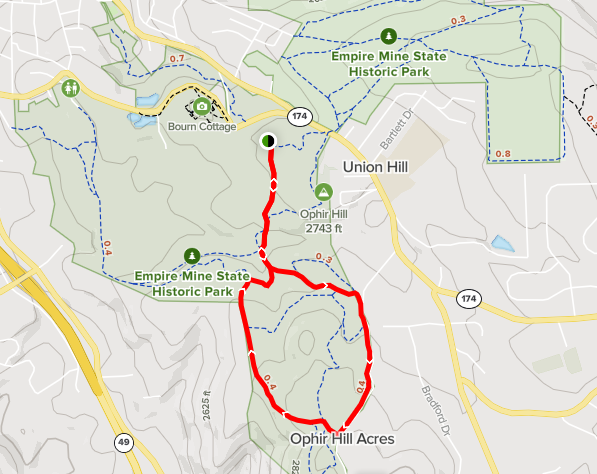
Ophir Hill and Historic Mines; 5.7 miles
This trail begins at the Penn Gate and takes you up towards the main Empire Mine parking lot, this portion of the trail is the Hardrock Trail. But it shoots off to the right as you ascend the hill taking you towards the Orleans Hill. The trail will wind up through the woods towards HWY 174 where you will cross it. From here the trail is a bit less traveled than the others inside the main portion of the park.
Once across the highway the trail then becomes the Lower Union Hill Trail. Stay on this trail and to the left, it then becomes Upper Union Hill Trail before becoming Indian Ridge Trail and down to Pipeline. This will loop you back to the Lower Union Trail and back to HWY 174.
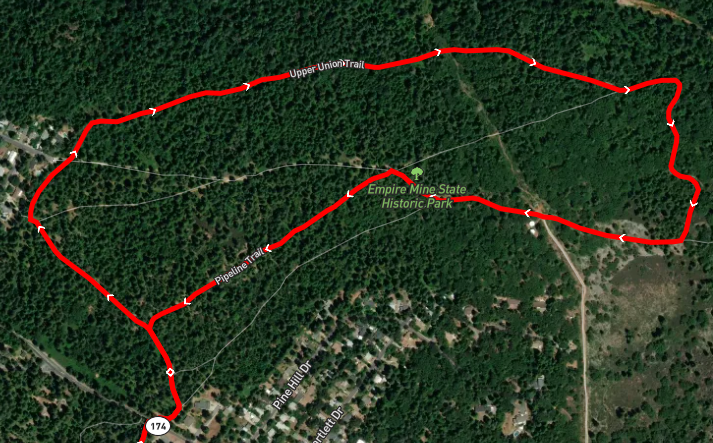
Be sure to map it before you go as there are a few offshoots from this trail. I'm not sure how good the cell service is there, I know that cell service is spotty by Union Hill School.
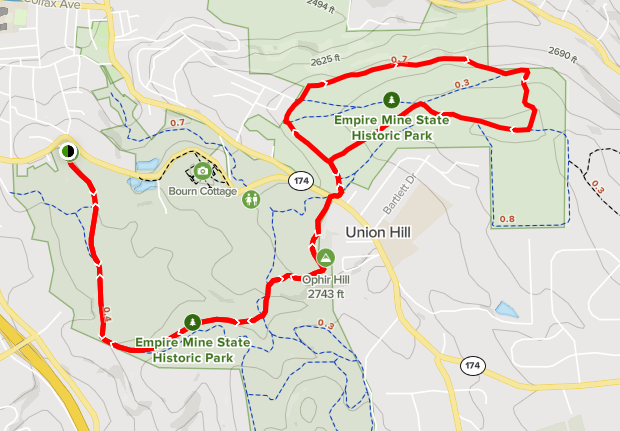
What's Nearby?
Depending on the time of year when you visit, there are many things to do and see. During the summer months, downtown Grass Valley has a Farmers Market on Thursday evenings. Depending on the year, either Grass Valley or Nevada City hold a 4th of July Parade. In the winter, just after Thanksgiving, you can enjoy Cornish Christmas in Grass Valley or Victorian Christmas in Nevada City.
About an hour away, you can go over the Donner Summit to see Donner Historical State Park and check out Alder Creek, or head over to Truckee for lunch before going to Lake Tahoe for the night.
Helpful Resources:
The Empire Mine is a favorite of mine, and I have been many times in my life. It's a great place to take folks who may be visiting from out of town.
- California State Parks
- Historical Newspapers
Excellently written! This explains many of the features of this State Park, and there is still plenty more to see and do there. Thanks for sharing part of our heritage with all of us.
Thank you Gerry! It was fascinating to learn about George McKnight. Also during my research in newspapers.com I found info on a Mr.Tinloy (Tinloy St.), that was interesting. I’ve been meaning to go by his grave over in Grass Valley. Thanks for reading my article.


Sacramento Valley
Stories from the valley
The Empire Mine State Historic Park: A Hidden Historic Gem
Contributed by keli gwyn.
The Empire Mine State Historic Park, located four miles southeast of Downtown Grass Valley, offers something for everyone. For those who admire beautiful buildings, the Empire Cottage, home of original mine owner, William Bourn, Junior, is sure to delight. Built in 1897 at a cost of $25,000, this English manor-style home sits amid thirteen acres of expertly landscaped grounds that include lush lawns, a duo of sparkling fountains, a reflecting pond, a heritage rose garden, and more. Lovers of nature will be in their element.
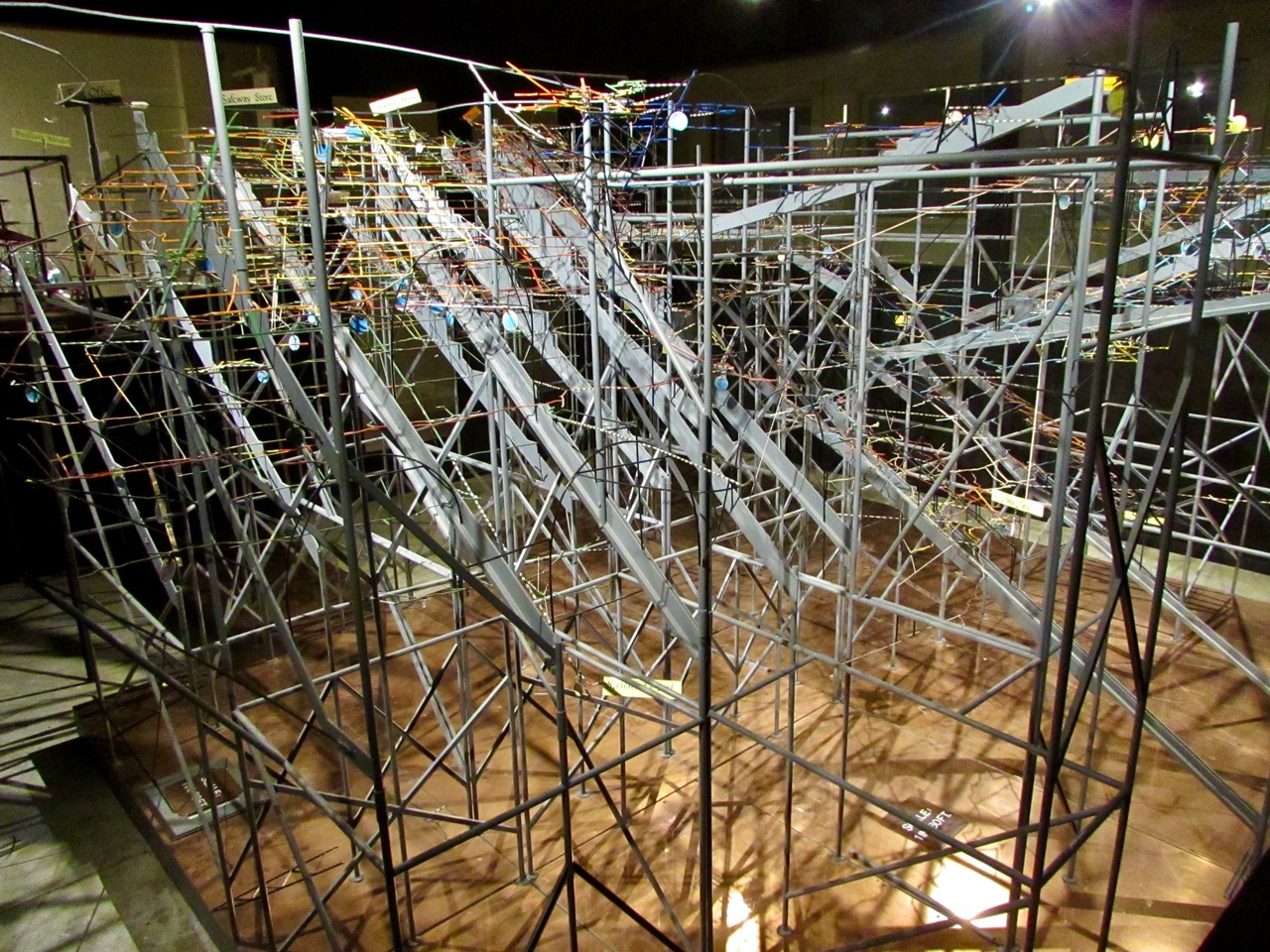
History buffs can unearth many interesting facts as they tour the mine, which was once the state’s richest producer of gold. Bourn operated the Empire Mine independently until 1929, when it merged with the North Star Mine. Starting in the Visitors Center, you’ll find a scale model of the Empire-Star Mine, which was kept in a blacked-out “Secret Room” during the days of the mine’s operation. It depicts the five square miles filled with underground workings, all 367 miles of them!
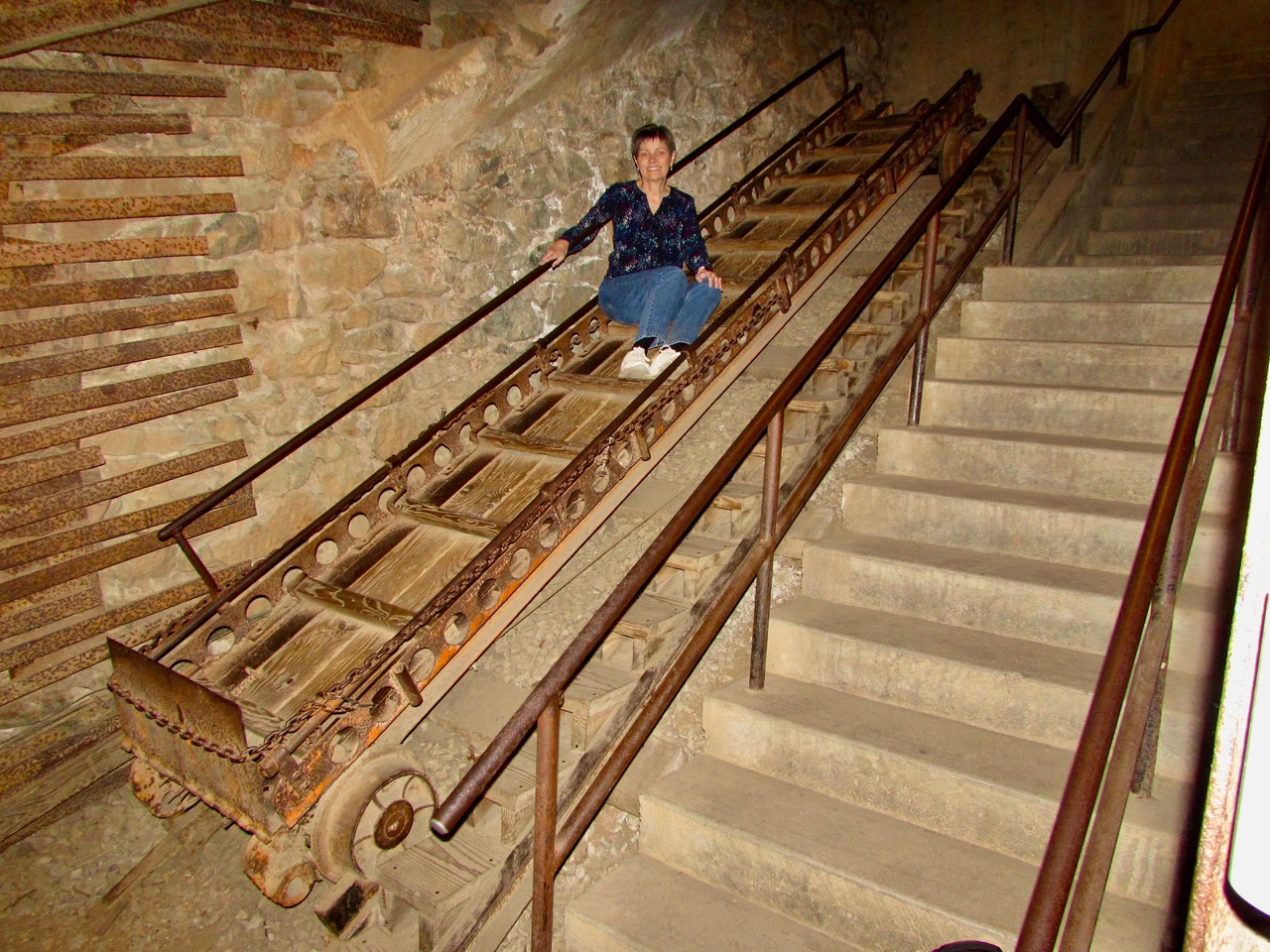
A stop at the shaft viewing area is sure to impress. Miners, sitting in long, skinny manskips, were whisked into the depths of the mine at a rate of 600 feet per minute. Considering the deepest shafts were 11,000 feet below the surface, these brave argonauts were in for quite a ride as they entrusted their lives to the skills of the hoist operator. Equally essential were the men who ensured the compressors that provided air for breathing and power for drilling were in working order.
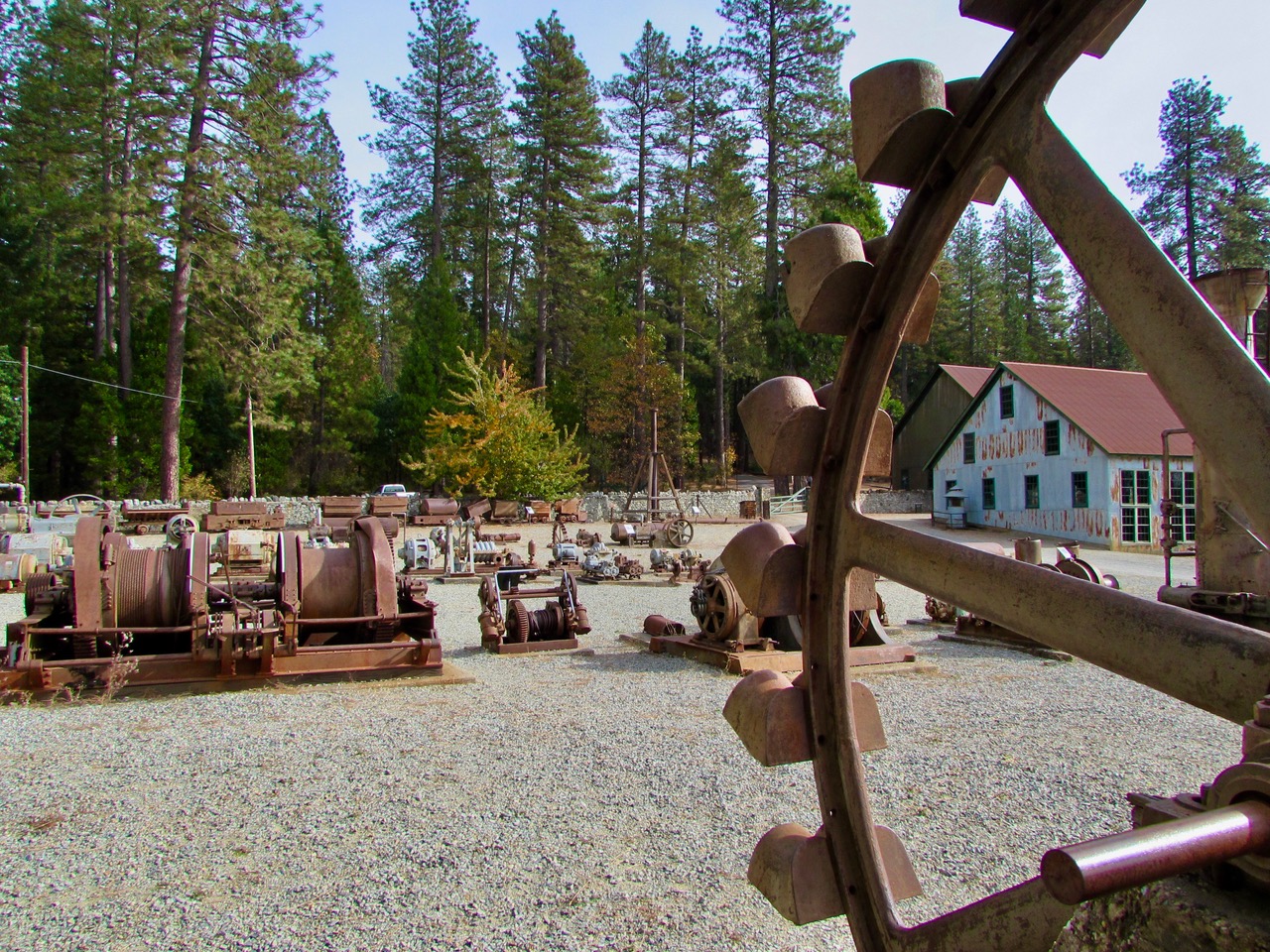
Visitors with an engineering bent will be captivated by the machinery, as was my scientist husband. Some pieces can be viewed in the Compressor Building, Hoist House, and Machine Shop. More are on display in the mine yard, including hoists, compressors, pumps, ore carts, and a Pelton Wheel.
Encompassing 856 acres in the forested Foothills, the park includes several hiking trails for those who would like to get some exercise while taking in more historic sites, including several abandoned mines. The trails vary in length and difficulty, so be sure to consult the guide available in the Visitors Center. Hikers are encouraged to wear sturdy shoes and carry water.
Visitors eager to welcome the holidays are in for a treat. Holiday Magic at Empire Mine, an annual event traditionally hosted Thanksgiving weekend, will take place November 29 and 30, 2019 from 11 am – 4 pm. You’ll encounter docents in turn-of-the century attire throughout the park. Santa and Mrs. Claus will hold court in the Clubhouse. The Empire Cottage will host an open house. With live music, chestnut roasting, and tasty confections, this will be a wonderful way for those of all ages to welcome the holiday season.
For more information about the Empire Mine State Historic Park, including directions, follow this link . A memorable experience awaits you at this hidden historic gem.
- Empire Mine State Historic Park
Check out videos on hundreds of California adventures
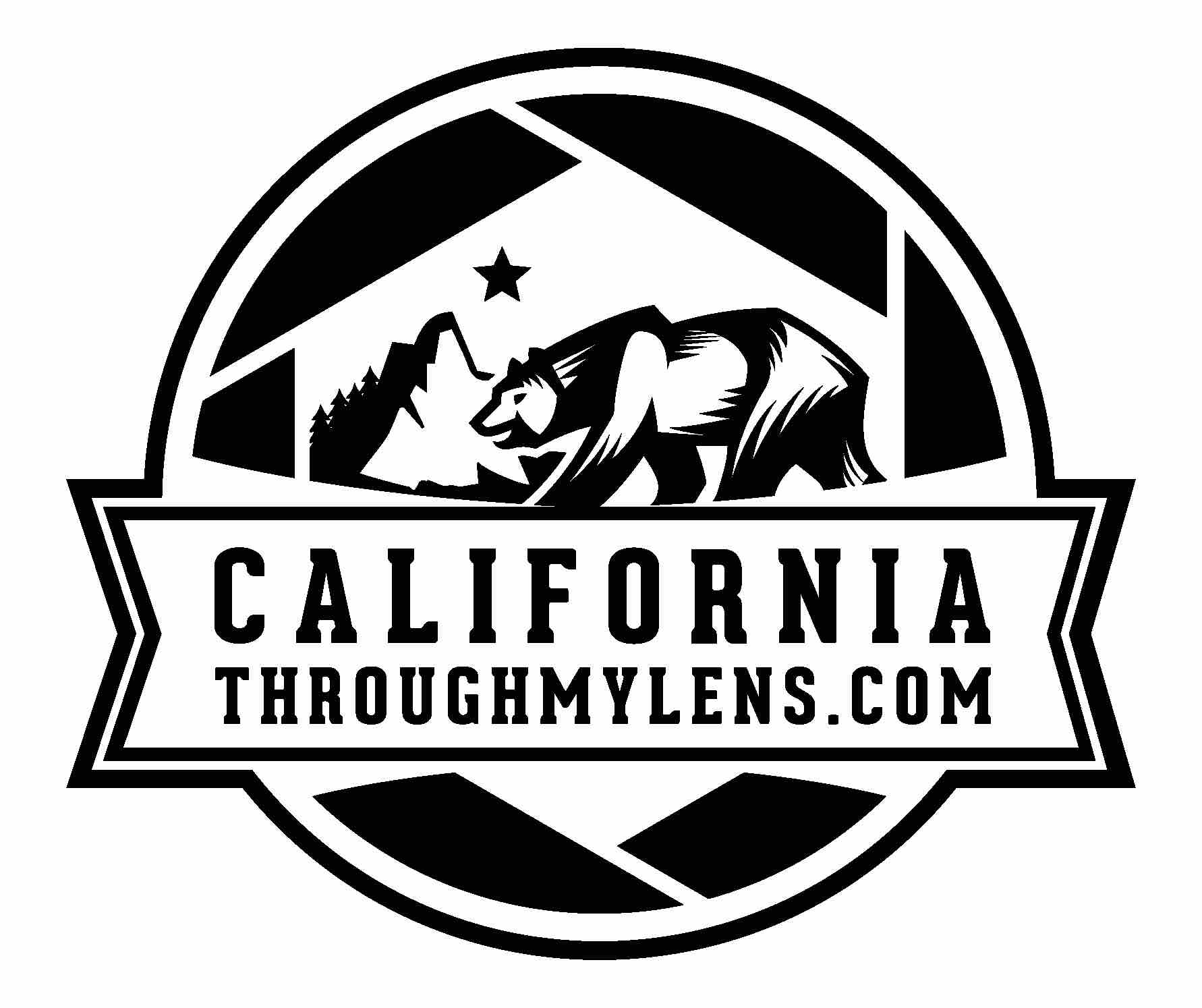
Empire Mine State Historic Park: Exploring one of California’s Richest Gold Mines
Empire Mine State Historic Park is home to one of the richest and longest running gold mines in California. The mine ran for over 100 years and was able to extract more than 5.5 million ounces of gold. When it stopped operations in 1956, it was eventually turned over to the California state park system , which now runs it as a state historic park. I finally got a chance to spend a half-day here, and even though I was not able to go underground, I still enjoyed this fascinating part of California’s gold mining history. Here is all the information if you want to check it out.
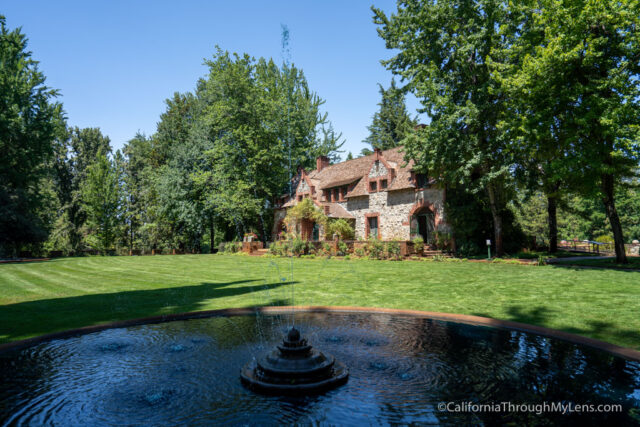
- Hours: Everday 10 AM – 4 PM (double check this before going)
- Cost: $7 per person
- Location: 10791 E Empire St, Grass Valley, CA 95945
Getting There
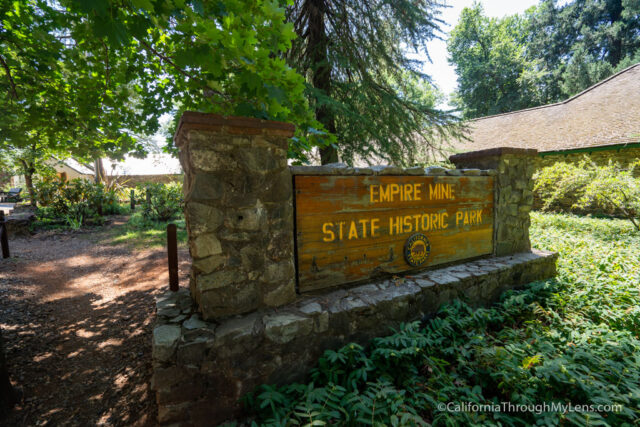
Empire Mine State Historic Park is located northeast of Sacramento in Grass Valley. It takes about an hour to drive there, and you will take Highway 80 north to Highway 174. This road winds around for about 14 miles before arriving at the park. There is a lot of parking right next to where you enter.
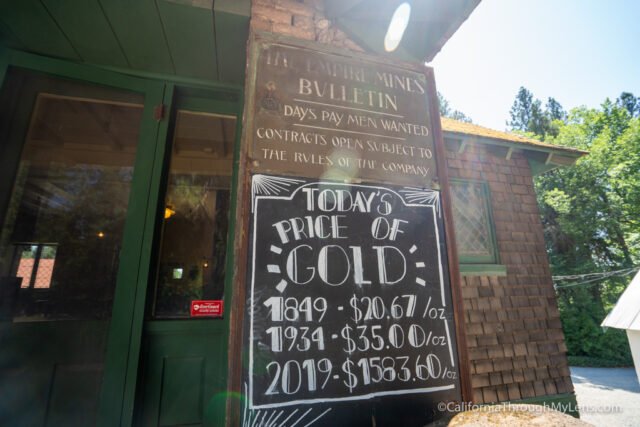
After parking, proceed to the visitor’s center where you can pay your fee, browse the small museum, and head out back to explore the area.
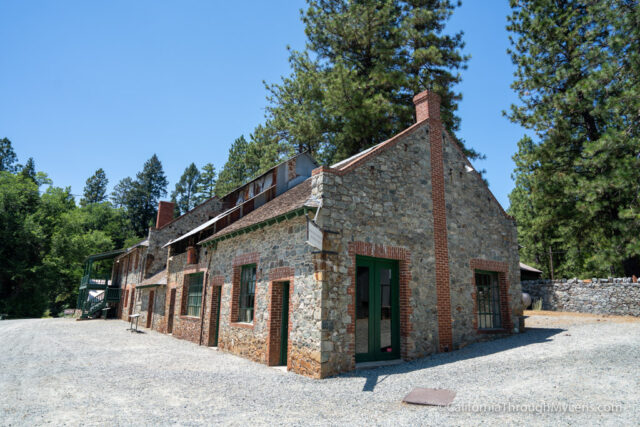
This area is vast and has a lot to see, so be sure to give yourself at least a few hours. I started by heading over towards the mine building first.
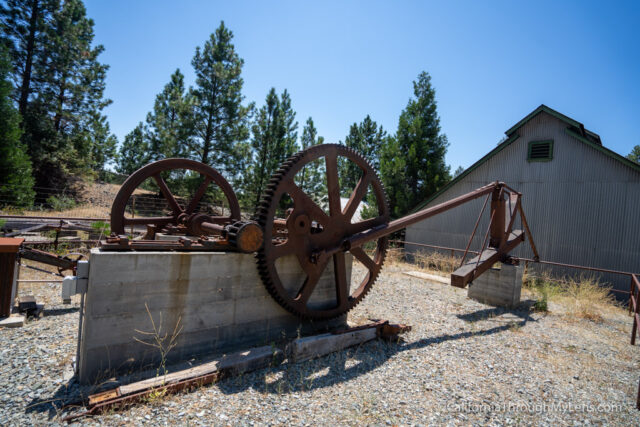
As you walk over, you will pass by a small row of buildings, which include the refinery building and the mine manager’s office. Each of the buildings has things you can see inside as well (if it is open, or you can just peek through the windows).
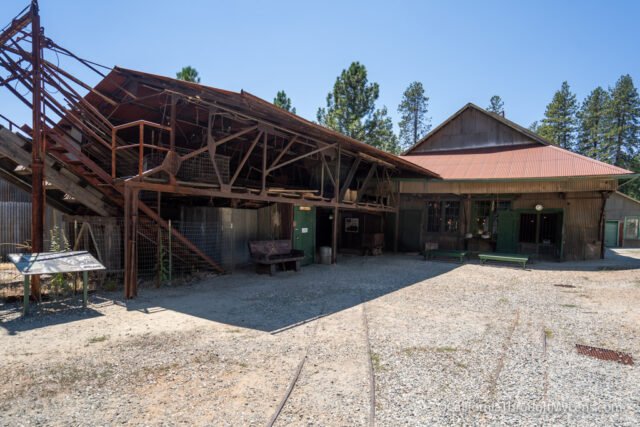
Across from these buildings is the machine shop and the mine shaft viewing area.

The machine shop has lots of open windows; you can peek in to see what the interior looks like.
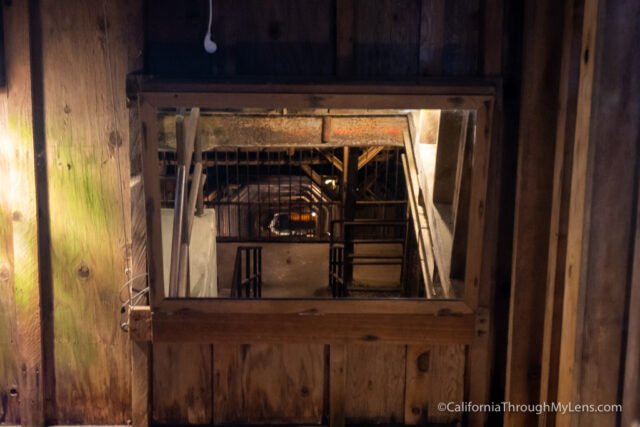
The mine shaft area has a small window that lets you look down into it. I thought the view would be a little better here, but I was just excited to see anything since I went when the tours were canceled during the pandemic.
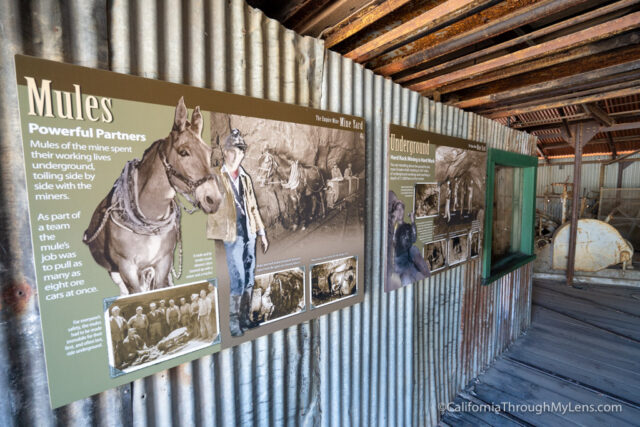
There are also lots of information plaques here you can read to learn more.

Next to that building is the blacksmith’s shop that you can look into and the compressor building.
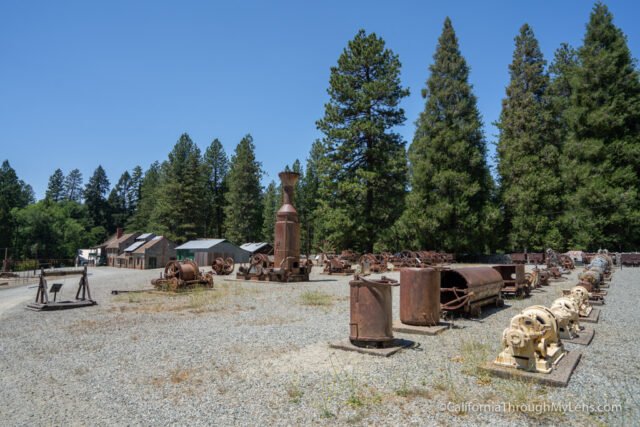
There are also dozens of old mining tools outside the buildings if you want to see what the miners used.
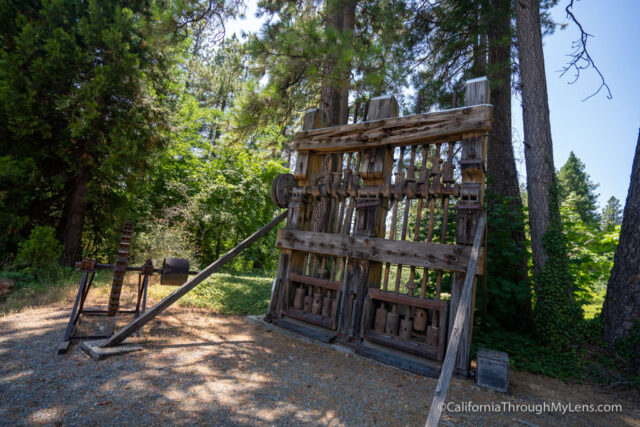
After exploring the buildings used in the day to day operation of the gold mine, be sure to explore the other half of the property as well. On the way over there, note where the stamp mill used to sit, but little is left of it now.
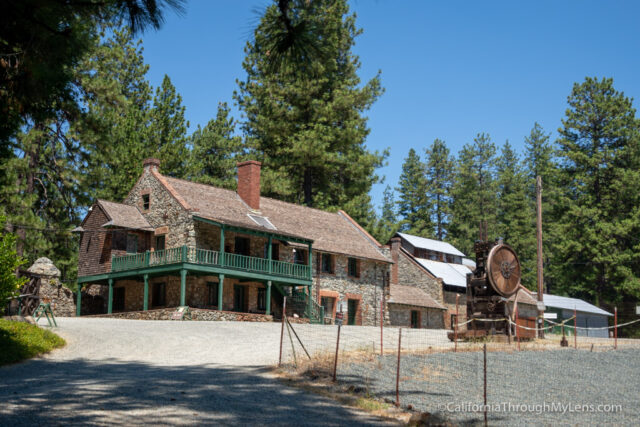
The rest of the property is the living quarters for the Bourn family, which owned the mining operations.
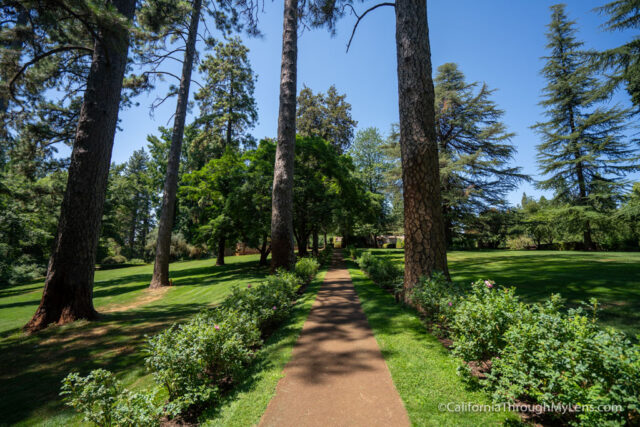
The first building you will see as you walk is the Empire Clubhouse, which was built to entertain guests. It is a huge building, and I was told it is still used for some events.

From there, walk along the tree-lined pathway that takes you up to Empire Cottage.
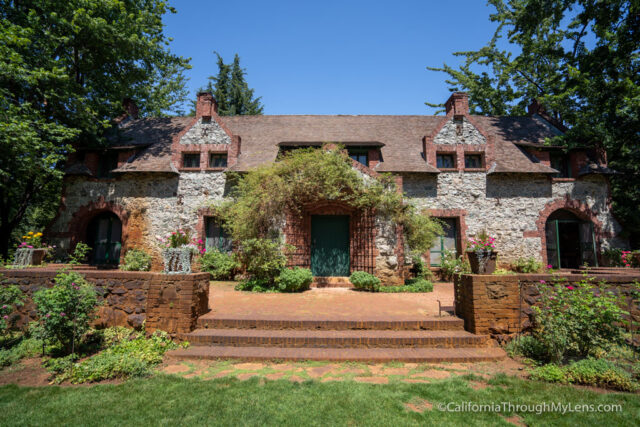
This immaculate house was built in the late 1800s and was one of the Bourn family’s residences.
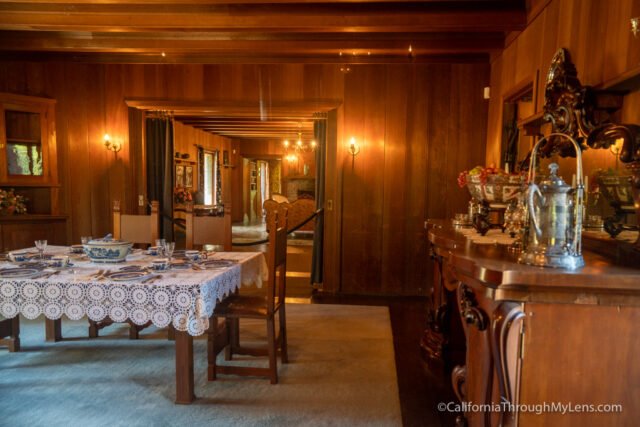
I didn’t get to go inside (just look through the windows), but it was cool to see from the outside.
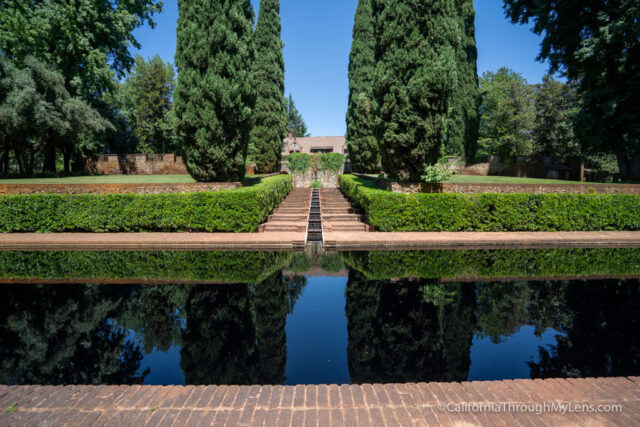
Be sure to walk down to the reflecting pool as well, which has many great angles for photos of Empire Cottage and another tree-lined walkway.

The last thing to see before leaving is the garden on the other side of the cottage.
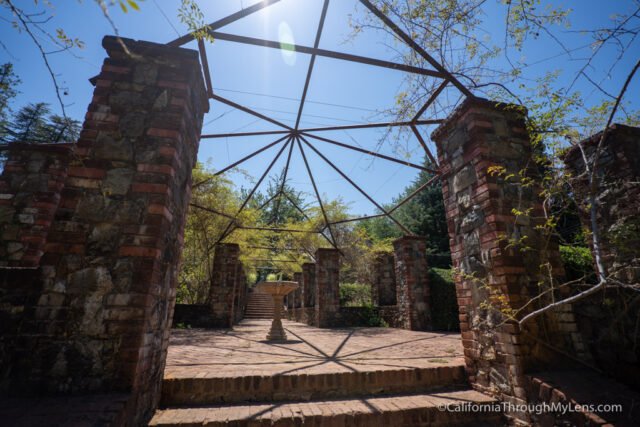
The garden has many different rose bushes and other plants that were grown in the attached greenhouse. While it was not in the best condition when I went, it was still a beautiful spot to stroll with lots of flowering plants.
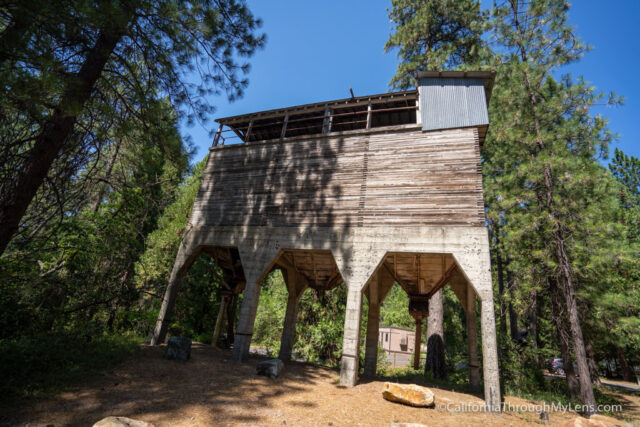
After soaking it all in, I started the drive back to Sacramento . This state park was worth the wait to visit, and I truly enjoyed my time there. I hope to go back in the future when the tours are happening so I can see the mine itself. Let me know what you think in the comments.
Similar Posts

BJ Cinnamon: Raspberry Creme Fritters in Folsom
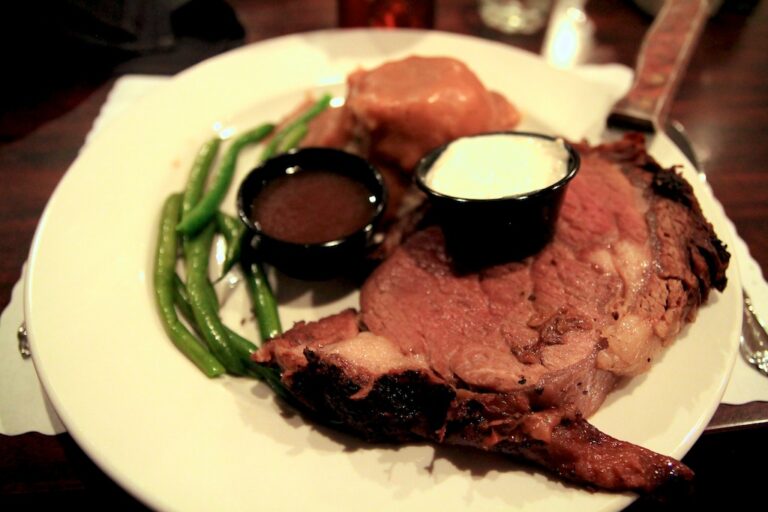
The Green Barn Steakhouse: Prime Rib in Red Bluff (Closed)
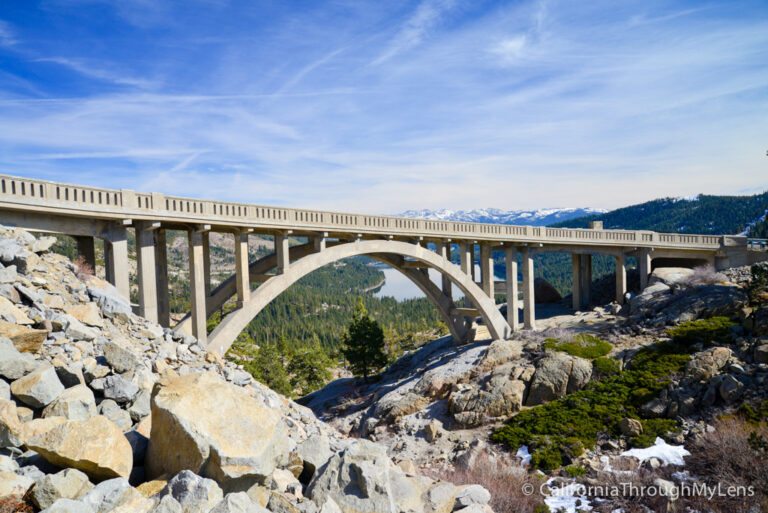
Donner Summit Bridge: Rainbow Bridge over Donner Pass
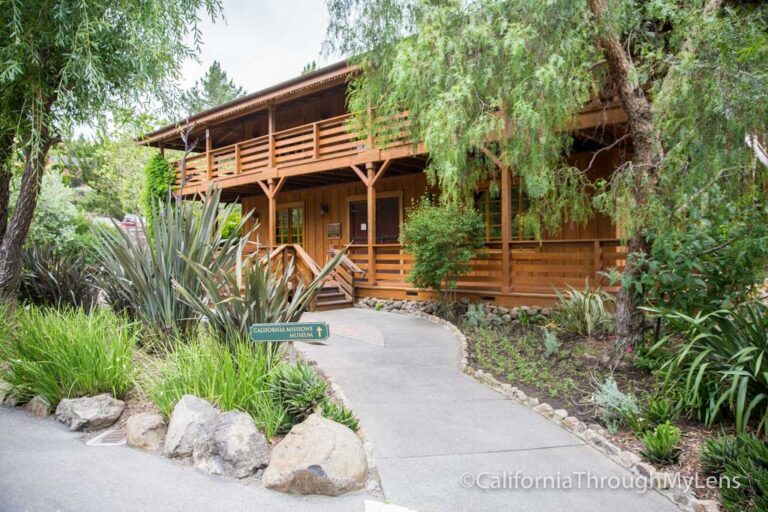
California Mission’s Museum & Cline Cellars in Sonoma
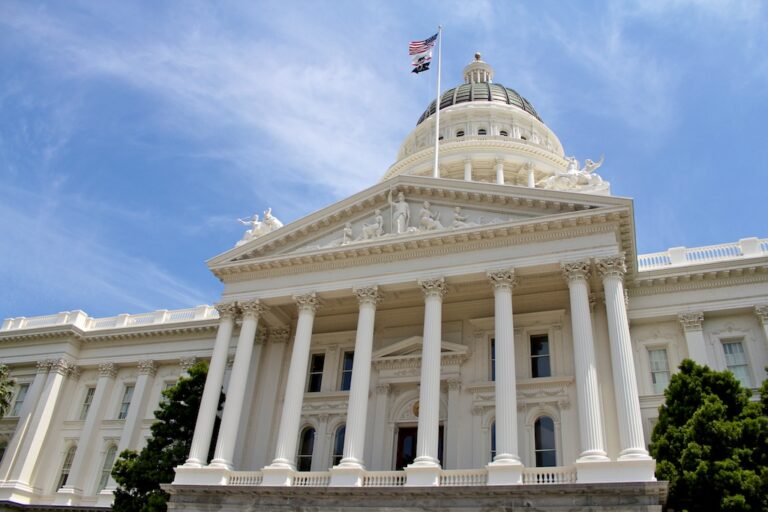
California’s State Capitol in Sacramento
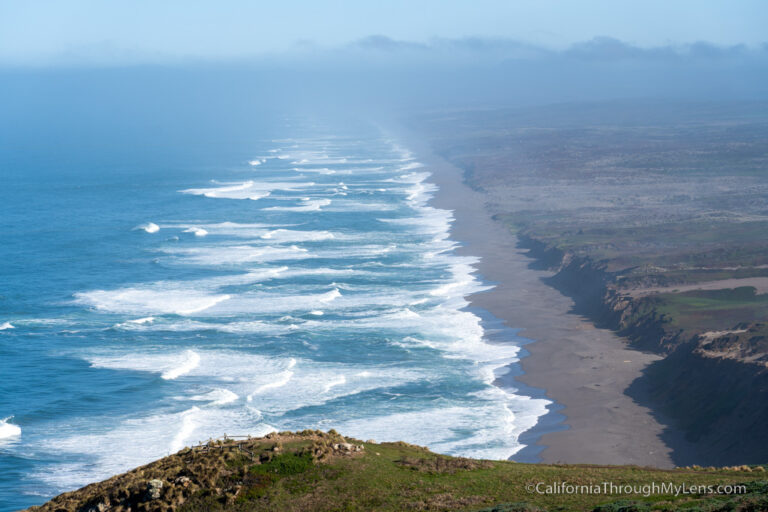
How to spend the perfect day in Point Reyes National Seashore (Full Itinerary)
Empire Mine State Historic Park
Gold Country
Atop 367 miles of mine shafts tunneling almost a vertical mile beneath the surface, Gold Country’s best-preserved gold-quartz-mining operation is worth a solid half-day’s exploration. From 1850 to 1956 the miners here, mostly Cornish, produced 5.8 million troy ounces of gold (worth about $8 billion today). The visitor center has maps and leads guided tours (schedules vary). See the website for events.
It's very well worth paying to enter the mine yard, littered with mining equipment and buildings constructed from waste rock, and to view the main shaft's claustrophobic entry, next to the former site of the head frame (a tall structure used to haul ore and people from underground). Nearby is the English-manor-style summer cottage and 13 acres of gardens belonging to the Bourn family, who originally owned the mine; though this now appears incongruously idyllic, the noise of the mining activity must have been deafening.
Hiking backcountry trails that meander past abandoned mines and equipment is free. Trailheads are located at the parking lots behind the visitor center and Penn Gate to its west.
10791 Empire St
Get In Touch
530-273-8522
https://www.empiremine.org
Lonely Planet's must-see attractions
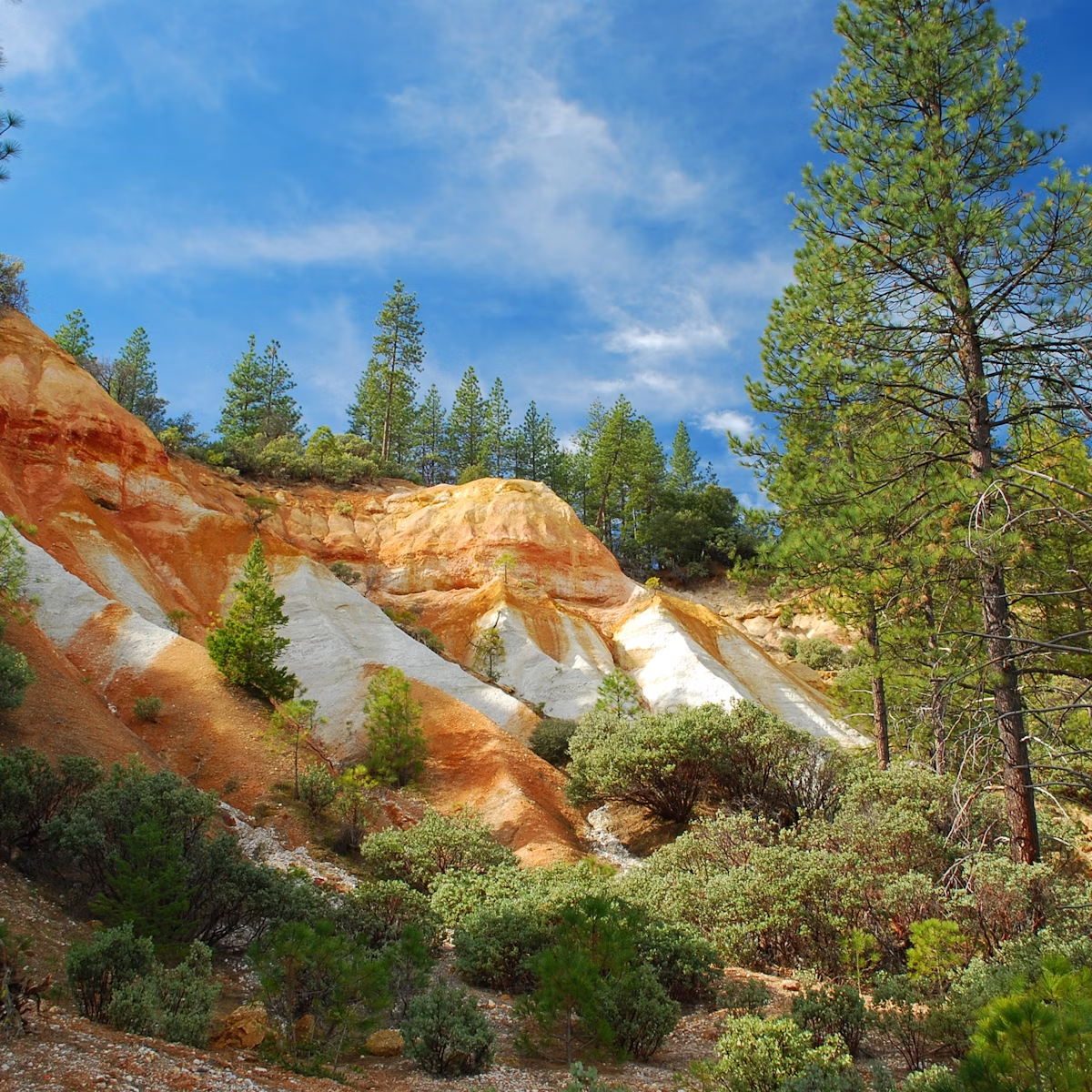
Malakoff Diggins State Historic Park
13.32 MILES
An otherworldly testament to the mechanical determination of the gold hunt, Malakoff Diggins is a place to get lost on fern-lined trails and take in the…

Marshall Gold Discovery State Historic Park
29.01 MILES
This state park comprises a fascinating collection of buildings in a bucolic riverside setting at the site of James Marshall's riot-inducing discovery…

South Yuba River State Park
10.06 MILES
Cool off with a dip at South Yuba River State Park, which has popular swimming holes and hiking trails. It's near Bridgeport, which has the USA’s longest…

Auburn State Recreation Area
20.99 MILES
This is a park of deep gorges cut by the rushing waters of the North and Middle Forks of the American River, which converge below a bridge on Hwy 49, 4…

Firehouse No 1 Museum
This small, painstakingly curated museum is run by the Nevada County Historical Society from a unique white wooden building with a tall bell tower. From…

Placer County Museum
21.43 MILES
The 1st floor of the domed 1898 Placer County Courthouse has Native American artifacts and displays of Auburn’s transportation heritage, including a…

North Star Mining Museum
A museum for those who ache when they see machinery set aside to rust. The engineering-minded docents here have polished and oiled their extensive…

21.57 MILES
Built by the Yue family in the 1920s, this clapboard residence stands on 'Chinese Hill,' one of many Chinese communities established during the gold rush…
Nearby Gold Country attractions
1 . North Star Mining Museum
2 . Nevada City Winery
This popular winery excels with Syrah and Zinfandel varietals, which you can savor while touring the production facility in the old Miners' Foundry Garage…
3 . Firehouse No 1 Museum
4 . South Yuba River State Park
5 . Malakoff Diggins State Historic Park
6 . Auburn State Recreation Area
7 . Placer County Museum
8 . Joss House
Inspired Imperfection
Food, adventures, & musings on juggling a business, loving a family, living inspired, and embracing imperfection
Empire Mine State Historic Park
Published By Jennifer Bourn on June 6, 2015
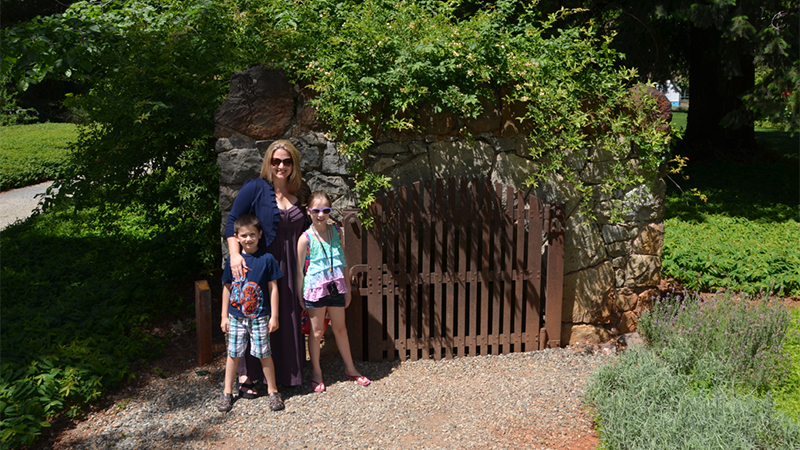
It’s one thing to learn about California history and the famous California Gold Rush in school, reading about it textbooks and watching movies or researching it onkine or in books for a project, but it’s a whole different type of learning when you get to experience it first hand.
Experiencing history — seeing it, touching it, tasting it, hearing it, smelling it — is an opportunity to not just memorize facts to past a test, but to actually learn and retain information that will stay with you for life. It is for this exact reason that our family loves to go on our own family field trips and adventures, exploring historic mining towns and gold rush towns, and old gold mines, museums, and living history events of all types.
Two of our favorite historic gold rush sites are the Marshall Gold Discovery State Historic Park in Coloma, California and the Empire Mine State Historic Park in Grass Valley. I had visited both on school field trips when I was in fourth grade, and I looked forward to sharing the experience again with my kids and relearning some of the history I had forgotten.
Empire Mine State Historic Park is the site of one of the oldest, largest, deepest, longest and richest gold mines in the state of California. In operation for more than 100 years, the gold mine produced 5.6 million ounces of gold (more than eight billion dollars worth by today’s standards) before it closed in 1956 . The park features many of the mine’s original buildings, including the Bourn Cottage and the Club House, as well as restored gardens, old mining equipment, the ruins of mine manager George Starr’s family home, and artifacts.
You can also peek in the entrance to 367 miles of abandoned and flooded mine shafts with a vertical depth of over 5000 feet.
Empire Mine State Historic Park’s 800+ acres also offers twelve miles of scenic trails for hiking, biking, dog walking and horseback riding. Some trails pass heavily mined or inhabited areas, while others meander through fields of mining features such as waste dumps and placer mining landscapes.
We skipped the hiking. Not only were we unprepared, but it was already really, really hot and it would have just been a sweat hike — which we’re not into doing.

Living History And Tours
Our visit to Empire Mine began in the Visitors Center, which used to be the carriage and automobile house. The woman working at the front desk was really helpful, pointing out all of the important items in the park we should make a point to see, including the mineyard, the Bourn Cottage, the gardens, and the blacksmith shop.
If you visit the park during a living history day, the park comes to life with gold rush era characters in lavish period costumes. Ask them questions and experience a working day at the mine.
While guided tours of the cottage, mineyard, and gardens are available and included in the park’s admission fee, we grabbed a brochure and park map and set out on a self guided tour that started with the scale model of the underground workings of the Empire/Star Mine, the Gold Room with ore samples from local mines, and the Assay Office. We also got to check out:
- The Club House: The old tennis court site, the squash court, bowling alley, billiards table and the stately ball room
- The Mineyard: Get a first-hand look at the behind-the-scenes work that made the mine prosperous, including the Mineyard Office, the stamp mill remains, the Machine Shop, and the Blacksmith Shop
- The Bourn Cottage: Meet docents in early 1900s’ costumes portraying not only the Bourns, but the Starrs, as well as the chatty, charming housekeeper Katie Moriarty
- The Gardens: See nearly 1,000 vintage rose bushes of 56 different varieties — many from the original plantings around 1897 — and other plants and flowers
The Bourn Family Cottage
The Bourn Cottage was built for William Bourn, Jr. as a summer home for the Bourn Family. Designed by San Francisco architect Willis Polk, the 4,600 square foot Cottage was built out of local granite and used brick for the window and door surrounds and trim. The residence features a steeply pitched side-gabled roof, parapeted gables, dormers, multiple chimney shafts, round-arched entryways, and interior wood casement windows.
The cottage grounds include two large circular fountains on a sprawling green lawn, a greenhouse, large stone walls, a formal garden, brick and metal terraces, and a reflecting pool. Today the Bourn Cottage gardens are maintained by a State Park staff gardener and volunteers — and in the springtime, when everything is in bloom, they are absolutely spectacular.

Empire Mine History
In the early 1900s, Empire Mine was on top of the world. Its stamp mills pounded non-stop 24 hours a day. During the Great Depression, businesses across the country were failing, yet under the direction of owner William Bourn, Jr. and successful mine manager George Starr, the Empire Mine expanded operations and became the largest and most prosperous gold mine in North American history.
Here is a brief historical overview from the State Historic Park Brochure And Map , explaining the Empire Mine’s history:
In 1850, prospectors found gold-bearing quartz in what is now Grass Valley. Traditional placer mining methods, in which water was used to wash gold deposits from the sand or gravel of stream beds, was ineffective in this area. Instead, the miners used “hardrock” mining methods, in which men in buckets were lowered into deep shafts (coyote holes) resembling water wells to chip and drill through the rock. After filling the drill holes with black powder, they detonated it, loaded the blasted rock into ore cars and took it to the mine headframe for primary crushing.
At the stamp mill, the crushed ore, mixed with water, was placed on copper plates coated with mercury. The mercury-coated copper combined with “free” gold to form an amalgam. Water washed away any impurities, and the cleaned amalgam went to the refinery for further processing.
In 1905 the Empire adopted a more efficient mining method. In this process, cyanide was used to dissolve gold while it was still embedded in the quartz. The gold could then be leached out of the quartz ore in a liquid form. The cyanide method is still in use around the world.
Until mules were introduced, miners moved the ore-laden cars manually. Known as one of the most efficiently operated gold mines in the U.S., the Empire counted among its improvements the use of mules to pull ore cars. The mules lived in underground barns until they became too old to work.
The Empire Mine did not begin to prosper until 1869, after San Francisco businessman William B. Bourn, Sr., acquired a controlling interest. Production dropped in 1874, followed by Mr. Bourn’s sudden death that same year.
In 1879, Mr. Bourn’s 22-year-old son, William B. Bourn, Jr., took over management of the mine to keep it from closing. Fortunately, he was able to lead the mine back to profit. He was later able to push several mine shafts past the 1,200-foot level that had been considered the maximum depth.
Mr. Bourn’s 19-year-old cousin, George W. Starr, began work at the mine in 1881. By 1887 he had gone from loading rocks and ore into cars (mucker) to superintendent. In 1893 Starr—by then considered a mining genius—left to work in South Africa’s gold mines. When Starr visited San Francisco a few years later, Bourn convinced him to return to the Empire, where Starr worked another 30 years.
After 1929 the Empire Mine—first combined with the North Star Mine as Empire-Star Mines Ltd. and then sold to Newmont Mining—produced enough gold to keep the Great Depression of the 1930s just a story in the local newspapers.
The mine closed during World War II when many miners enlisted. In 1945 the mine reopened, but gold was still at its 1934 price — $35 per troy ounce. Unfortunately, it then cost more to bring gold to the surface than it was worth. However, mining efforts continued for another decade. In 1956, when the Empire closed, it had yielded nearly six million troy ounces of gold — a true bonanza.
In April of 1975 the State of California bought the land (over 770 acres) and formed the Empire Mine State Park . The Empire Mine is on the National Register of Historic Places , a federal Historic District , and a California Historical Landmark .
Planning a Visit To Empire Mine
If you’re planning a family trip to visit Empire Mine State Historic Park , be sure to pack a picnic as there are many picnic tables near the parking area and large shaded lawns to spread a picnic blanket out on. Trust me, your kids will love running around on the lawns and around the ground while you relax!
Also be sure to check out their special events and living history days. Living History days are on select summer weekends only, and is included with your park admission — with the exception of the Cottage Living History Experience, which is a $2 additional charge.
Driving Dune Buggies Through The Pismo Beach Sand Dunes Next

Jennifer Bourn
Designer, Wife, Mom, And Life Juggler
With 22 years experience as a graphic designer and 16 as a web designer/ creative agency owner , Jennifer helps small businesses build brands, create content, and grow profitable online platforms. Her renowned business systems and automations allow her business to thrive while she travels with her husband of 21 years and two teenagers, squeezes in daily workouts , tries new recipes , embarks on ambitious craft projects, speaks at events, facilitates workshops , and leads online courses .
- Jennifer Bourn on Facebook
- Jennifer Bourn on Twitter
- Jennifer Bourn on LinkedIn
- Jennifer Bourn on Instagram
- Jennifer Bourn on Pinterest
- Jennifer Bourn on YouTube
- Jennifer Bourn's website
Many links on this site are “affiliate links.” This means if you click on a link and purchase the item, I may receive a small affiliate commission — it costs you nothing extra but helps me keep the lights on and the hosting for this site paid. All affiliate links on this site use "/aff/" in the URL to denote that it is an affiliate link. I am disclosing this in accordance with the Federal Trade Commission’s 16 CFR, Part 255: “Guides Concerning the Use of Endorsements and Testimonials in Advertising” and in following the rules of the Amazon Associates Program Operating Agreement. Yes, that means I am also an Amazon Associate and earn a small commission from qualifying Amazon purchases referred from links on this site.
Empire Mine State Historic Park
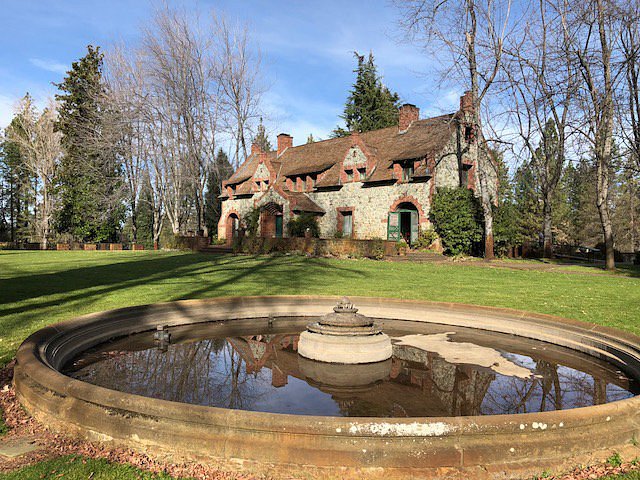
Top ways to experience nearby attractions
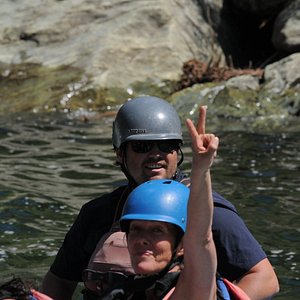
Most Recent: Reviews ordered by most recent publish date in descending order.
Detailed Reviews: Reviews ordered by recency and descriptiveness of user-identified themes such as wait time, length of visit, general tips, and location information.
Also popular with travelers

Empire Mine State Historic Park - All You Need to Know BEFORE You Go (2024)
Home | Hwy 49 Map | Cities Directory | Business Directory | Bed & Breakfast | Golf Courses | Wineries | Historic Churches
Gold Rush History | Historic Photo Gallery | Gold Facts | We The People | Ghosts | General Store | Old Sac | Tahoe | Yosemite
Empire Mine State Historic Park
Useful information.
This was the richest hard-rock mine in California producing 165,000kg of gold all together. The gold is part of a quartz vein in a massive of grey granite. Such veins are hydrothermal depositions formed by the heat of the granite intrusion.
Description
Empire Mine is the oldest, largest, and richest gold mine in California. The Historic Park contains many of the original mine buildings, the owners' cottage and the restored gardens and grounds. The park has an area of 342 ha and almost 20 km of hiking trails.
The gold was discovered by George Roberts , but he soon sold his interest. Since 1869 William Bourn Sr. owned controlling interest and the family maintained control until it was sold to Newmont Mining in 1929. The mine was closed in 1959 and almost twenty years later in 1975 it was purchased by the State. The Empire Mine State Historic Park was opened, which soon became a popular tourist destination. The main attractions are historical tours of the Bourn Cottage, the mine yard, and the Park museum. The museum shows a scale model of the underground workings of the Empire/Star mine complex. A gold room displays ore samples from local mines. There is also the Assay Office, and an extensive mineral collection. Visitors can see the video entitled Tears from the Sun which explains various gold mining techniques.
But all sights were above ground until now, although there were almost 600 km of abandoned and partly flooded mine shafts. So a few years ago the creation of an underground tour was started, called the Underground Tour Project . The California Cultural and Historical Endowment (CCHE) granted the Empire Mine State Historic Park and the Department of Parks & Recreation more than 1.2 million dollars for its completion. The construction of a Maintenance Building and the Orientation Center are almost completed, work has begun on the displays.
An adit was built horizontally through the quartz-laced grey granite, ending at the main shaft. At the moment phone, water and electricity are installed in the adit. The visitors will ride a mine train through this 250 m long tunnel. Dioramas depicting the advancement of hardrock mining techniques over the years will be constructed along the tracks, and the train will stop now and then. At the main shaft a so called stope will be visited, a huge cavern created by the upward mining of the quartz vein.

- General Information
- Terms of Use
- ©Jochen Duckeck
- Contact showcaves.com
Watch CBS News
Guide To The Empire Mine State Historic Park
November 11, 2010 / 12:17 PM PST / CBS Sacramento
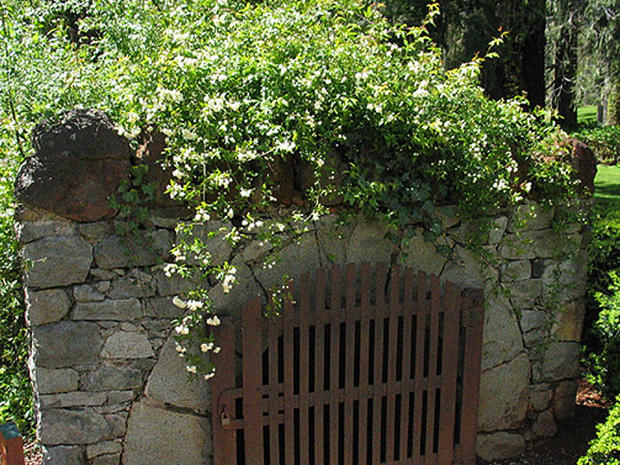
Mineyard Tour
You can see the tools and equipment used by miners. Make sure you learn about "The Secret Room". The room housed a scale model of mine's below the surface workings. The model can now bee seen in the Visitors Center.
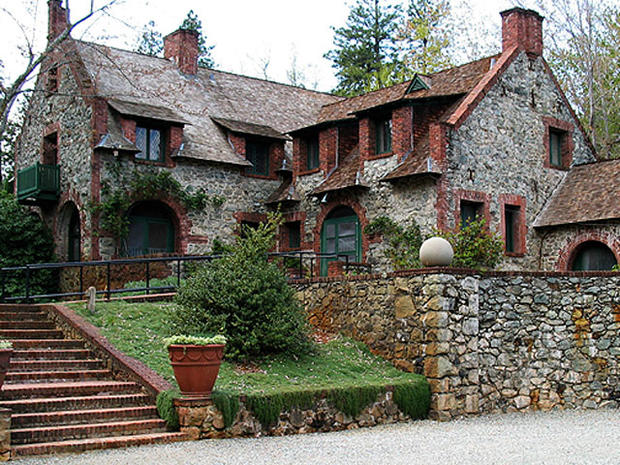
Cottage Tour
The tour of the cottages will take you through the history of the Empire Mine and its key players. You'll tour Bourn Cottage, the Clubhouse and the George Starr home ruins.
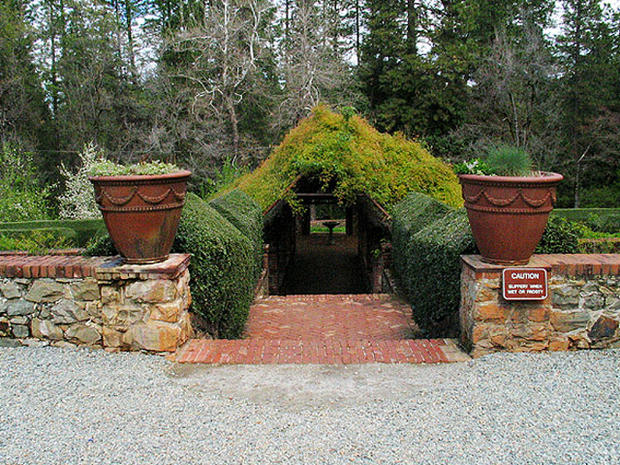
Restored Garden
The Empire Mine grounds reflected the wealth of the mine. The grounds included the homes of the mine owner William Bourn and superintendent George Starr. The gardens had large lawns with fountains, reflecting pools and a greenhouse. The gardens have been restored to circa 1905 with more than 950 rose bushes.

Hiking Trails
The 845 acre park includes about 12 miles of trails for hikers, bikers and horseback riding. The trails are open year-round from sunrise to sunset. The trails pass by many historic mining sites and old foundations. Trail maps are available at the Visitor Center.
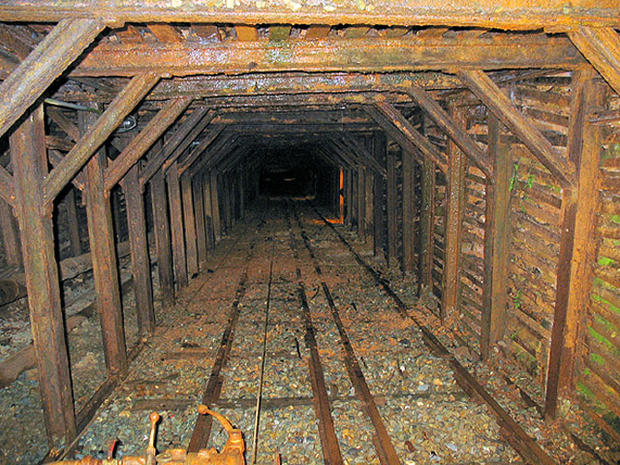
Underground Tours
The park plans to offer underground tours in early April 2012. Construction has begun so visitors will soon be able to go 800 feet down and see what it was like to mine for gold during the 1860's.
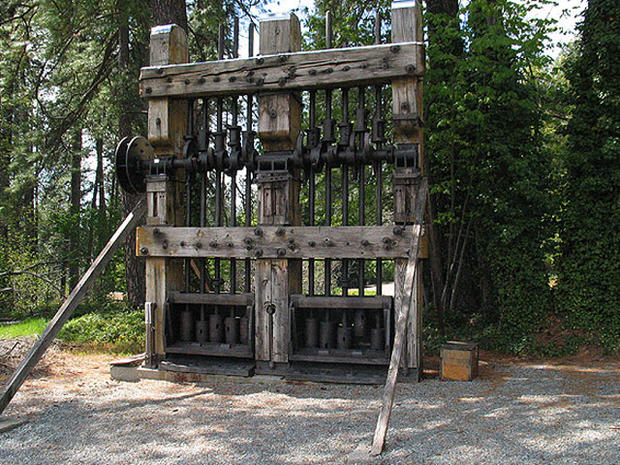
Empire Mine
10791 E. Empire Str. Grass Valley, CA 530.273.8522 Empiremine.org
Entrance fee: $5.00 for adults over 16, $3.00 for children 6 to 16, children under 5 are free. Tours: Cottage, Mineyard and Grounds & Gardens - $2.00 each (adults)
Featured Local Savings
More from cbs news.

Southbound I-5 traffic backs up for miles after big rig goes off overpass in Sacramento County
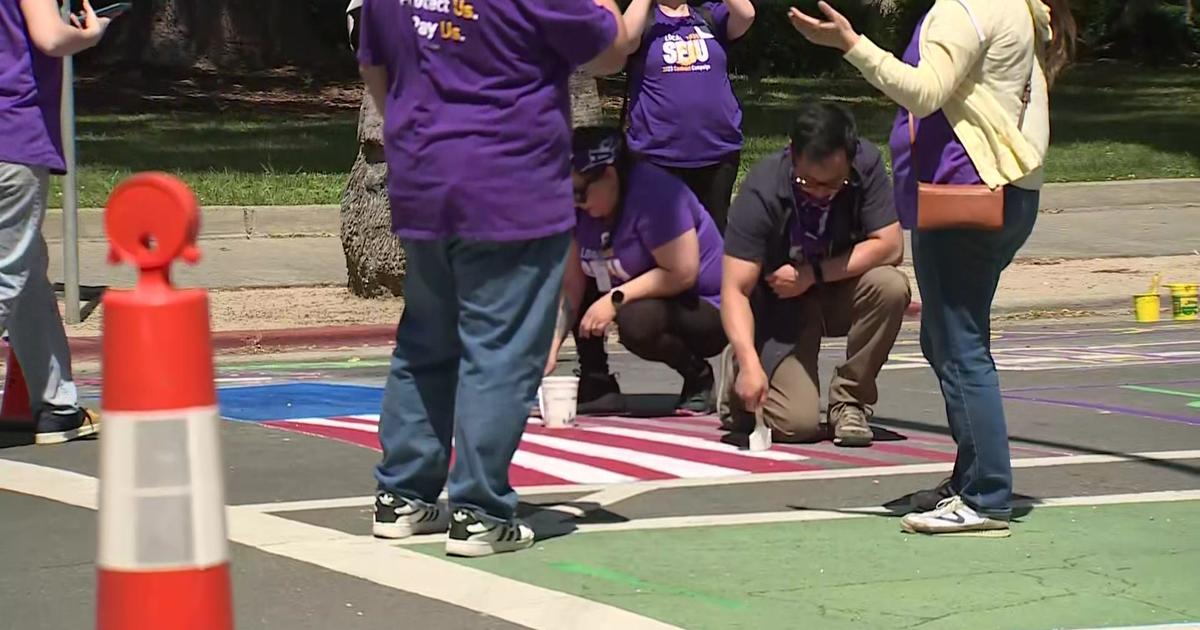
Labor groups paint street in unpermitted protest at California State Capitol on May Day
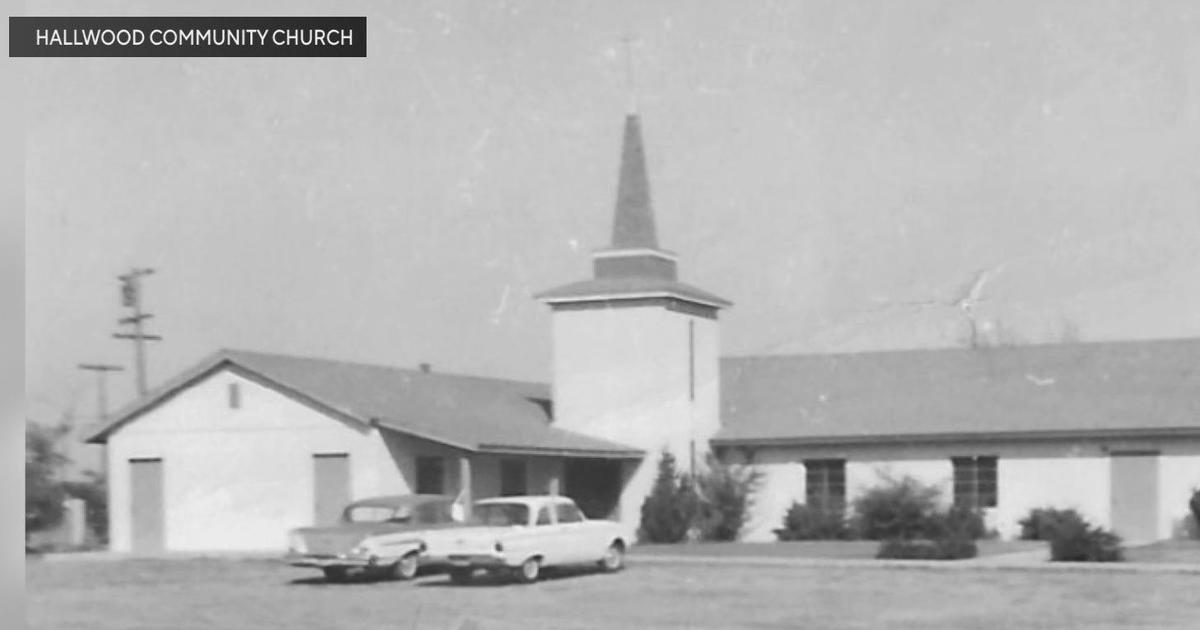
Yuba County church turns 100. This woman has been there for nearly all of it.
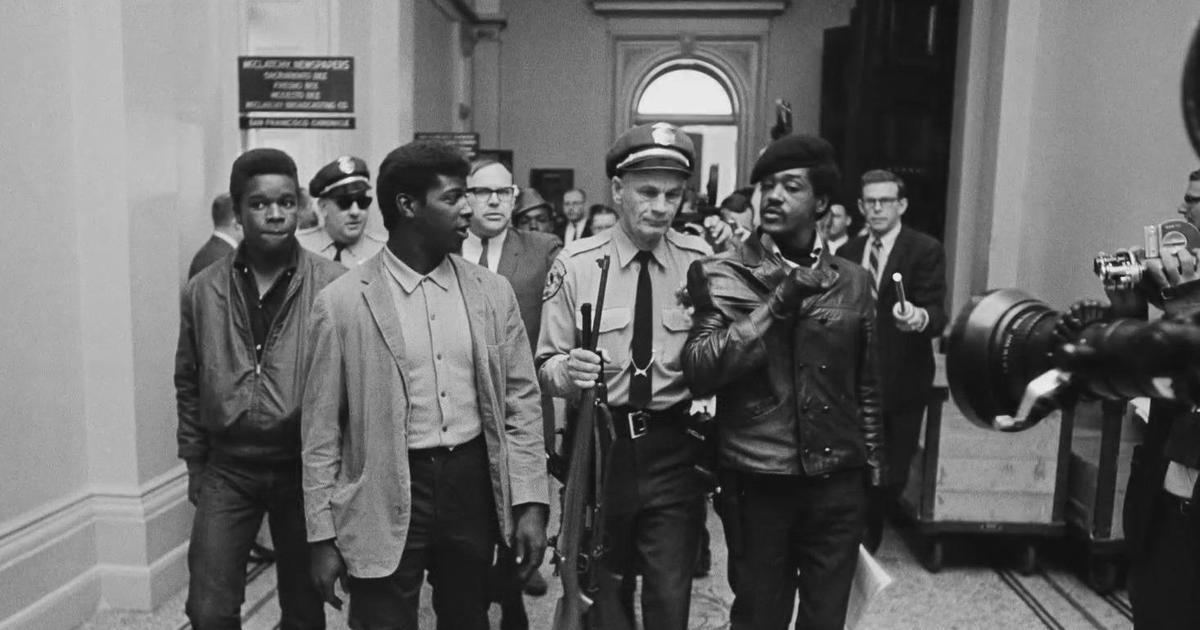
The lasting legacy of 1967 Black Panther gun control protest at California Capitol
Access Utility Billing Account
Get a permit or license, get zoning information, report a problem, review city fees, review environmental docs, empire mine.
State Historic Park
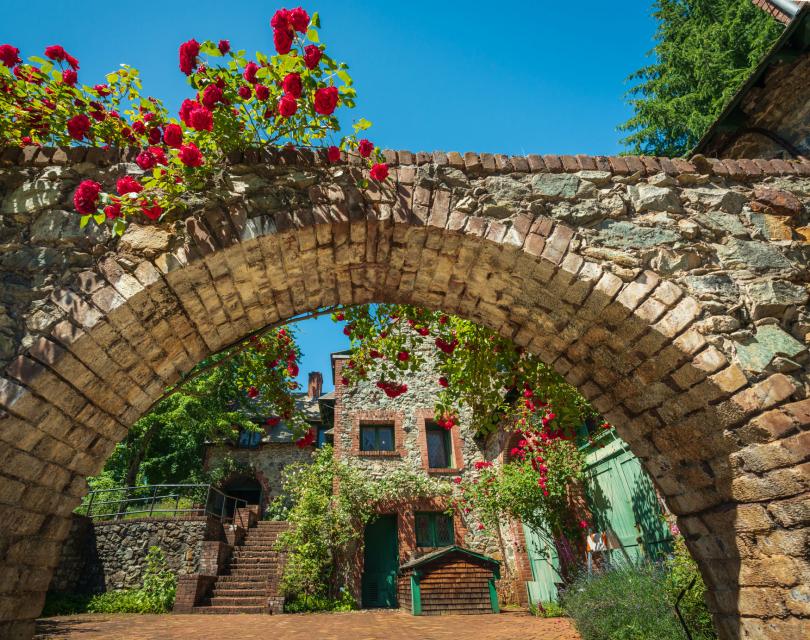
WILD EXPLORERS FIELD TRIPS
Bringing the classroom to life
Wed, May 03
Empire Mine State Historic Park
Empire Mine State Historic Park Tour (3rd-6th Grade)
Experience the rich history of the Empire Mine from its origins to the present day and learn how the gold rush in the Nevada County area helped shape California.

Time & Location
May 03, 2023, 10:30 AM – 12:30 PM
Empire Mine State Historic Park, 10791 E Empire St, Grass Valley, CA 95945, USA
About the event
For 3rd-6th Graders
Students will experience the rich history of the Empire Mine from its origins to the present day, in a period setting replicating the heydey of the Empire Mine. Students will learn the significance and implications of the gold mining industry in the Nevada County area, throughout California, and the world. They will learn how California's gold rush and the gold mining industry helped shape and develop California today (economically, culturally, and technologically). Students will have the opporutnity to tour through the lush gardens and Estate grounds, which starkly contrasts with the austere and begrimed Mine and Mineyard. Touring Empire Mine State Historic Park will stay with students for a lifetime.
Empire Mine State Historic Park is the site of one of the oldest, deepest, and richest gold mines in California. The park is in Grass Valley at 10791 East Empire Street. In operation for more than 100 years, the mine extracted 5.8 million ounces of gold before it closed in 1956. The park contains many of the mine’s buildings, the owner’s home and restored gardens, as well as the entrance to 367 miles of abandoned and flooded mine shafts. The park encompasses 856 acres of forested backcountry and fourteen miles of trails - including easy hikes (for hiking, mountain biking and horseback riding) - in the park.
In June and October 1850, gold was found within a mile radius of the Empire Mine’s site. A new gold rush began when hundreds of miners staked claims in the area. However, most of the gold was buried deep in the earth, veined in quartz. Extracting that gold required more sophisticated mining techniques than the panning and sluice-box methods used in nearby Coloma.
After many separate, smaller claims were bought and consolidated, the site officially became known as the Empire Quartz Hill Company in 1852. William Bourn, a major stakeholder in the company, gained a controlling interest in the mine in 1869 but died suddenly in 1874. His son, William Bourn Jr., began to run the mine in 1878 after the gold was thought to be played out at 1,200 feet. Empire Hill then entered its most fruitful period. Together with his cousin, mining engineer George W. Starr, the younger Bourn created a successful and modern mine that became one of the most productive in the United States.
Mining gold from the hard rock deep in the earth proved tricky. Experienced miners from Cornwall, England, immigrated by the hundreds. Well-versed in hard-rock tin and copper mining, the Cornish miners brought such advancements as the “Cornish pump” that helped empty underground tunnels of water that flooded into mine passages from underground springs. With Cornish miners’ supervision and labor, tunnels became as deep as a vertical mile.
More than 5 million ounces of gold (worth well over seven billion dollars today) were taken from the Empire Mine—estimated to be only 20% of the total gold deposits still buried under the park (and underwater).
In 1929 Bourn sold the mine to the Newmont Mining Corporation, which controlled the Empire Mine until its closure in 1957. Static gold prices after World War II prompted the closure. In 1975, the State of California purchased the mine.
Today, visitors can tour the entrance to the main mineshaft and the mining shops, buildings and equipment as well as the mansion, clubhouse and expansive garden that William Bourn Jr. built. The historical buildings are encircled by miles of lovely trails and woodlands accessible to the public. Empire Mine State Historic Park is a treasure, where generations of Californians were able to truly shout, “Eureka!”
Important Info:
- AGE/GRADE REQUIREMENTS: Tour is for grades 3-6
- ALLERGY ALERT: Please let us know right away if your student has a food allergy so we can make any necessary arrangements
- CANCELLATION/REFUND POLICY: Tickets for field trips will remain on sale until sold out or at the cut off date listed on the event, whichever comes first. Changes to your order can be made only while the field trip is open. Once a field trip closes, we are unable to offer refunds. Issues with orders such as insufficient or incomplete funds withdrawal may be subject to cancellation.
- CHAPERONE POLICY FOR TEACHER-LED FIELD TRIPS: Instructional funds may be used to order 1 adult/chaperone ticket per 4 enrolled students and 2 adult/chaperone tickets per 5 or more enrolled student, an adult chaperone is required to accompany student(s) on a field trip regardless of the student(s)' age or grade level(s).
- FOOD/DRINK RESTRICTIONS: Food and drinks may not be consumed inside. There are park benches outside.
- MEETING INSTRUCTIONS: Please gather at entrance by the parking area
- PARKING INSTRUCTIONS: There is plenty of available parking onsite
- SICK POLICY: To ensure the health and safety of all attendees, please do not attend a field trip if you or your student(s) is ill or showing possible signs of illness.
- RELEASE OF LIABILTY: When registering, make sure to read and understand the Release of Liabiliy Policy before submitting your order
If you are a parent using charter school funds, you will still need to register here for the event in order to hold your spot. Use the coupon code listed below when checking out. You will also need to put in your order with your charter school. They will reach out to us with your request and this will confirm your field trip reservation.
Charter Coupon Code: CHARTER
Student/Chaperone
Share this event.

History of Empire Mine
A high-risk history of vision, innovation and old-fashioned hard work.
Empire Mine’s history began in 1850 when George Roberts found hard-rock gold in a quartz vein – more than a year after James Marshall discovered placer gold at Sutter’s Sawmill. Suddenly, Northern California was a magnet for those seeking wealth, new opportunities, and adventure. People from all walks of life and from all over the world flocked here for a piece of the action.
In 1851, Roberts sold his interest, and by 1869, new owner, San Francisco entrepreneur William Bowers Bourn, Sr., held the controlling interest. The Bourn Family retained ownership until 1929 when Empire Mine was purchased by the Newmont Mining Company for $250,000. Operations ceased in 1956. The stamp mills that once thundered 24 hours a day were silent, and its glory days became a memory. In its heydays, Empire Mine produced 5.8 million ounces of gold, and it ranked as one of the largest, oldest and most prosperous mines in North American history.
Its purchase in 1975 by the State of California marked a new beginning for the historic site. Today it continues to lure visitors from all over the United States and all over the world. Empire Mine State Historic Park welcomes around 100,000 a year, as they discover what life was like in those days of gold, grit and glory. Its tours of Empire Cottage (the Bourns’ summer home), the Clubhouse, the gardens and the Mine Yard are fascinating. The Living History Programs, both in the Cottage and the Mine Yard, bring the past to life in a convincing, memorable way. Today the mine is almost completely filled with water , however visitors can still look down the mine shaft portal to the 150-foot level. Empire Mine’s close to 850 acres are rich in history and beauty. At elevations of 2,500 to 2,900 feet, they cover a maze of 367 miles of deep mine shafts. Located in the western Sierra Nevada, 50 miles from Sacramento, Empire Mine State Historic Park remains rich in gold-mine history.
Key dates in Empire Mine’s unique history
Mining methods.
Traditional placer mining methods that depended on using water to wash gold deposits from the sand or gravel of stream beds did not work in the Grass Valley area. Instead, miners used “hard-rock” mining methods. Men in buckets were lowered into deep shafts (coyote holes), resembling water wells to chip and drill through the rock. After filling the drill holes with black powder, they detonated it, loaded the blasted rock into ore cars and took it to the mine headframe for primary crushing.
At the stamp mill, the crushed ore, mixed with water, was washed cross copper plates coated with mercury. The mercury combined with “free” gold to form an amalgam. Water washed away any impurities, and the cleaned amalgam went to the refinery for further processing.
In 1905, Empire adopted a more efficient mining method. In this process, cyanide was used to dissolve gold while it was embedded in the quartz. The gold could then be leached out of the quartz ore in a liquid form. The cyanide method is still in use around the world.
Until mules were introduced, miners moved the ore-laden cars manually. Known as one of the most efficient gold mines in the U.S., Empire counted the use of mules to pull ore cars as one of its greatest innovations. The mules lived in underground stables until they became too old to work.
Empire Mine did not begin to prosper until 1869, when William Bowers Bourn, Sr. acquired the controlling interest. Production dropped in 1874, followed by Mr. Bourn’s sudden death that same year.
William Bowers Bourn, Jr.

He commissioned famed San Francisco architect Willis Polk (who had designed the Bourns’ Webster Street mansion in San Francisco) to design the mine managers’ complex, Empire Cottage, the magnificent gardens, and the Clubhouse, where the Bourns entertained their prestigious guests.
George W. Starr

Agnes Moody Bourn

Libby Starr
Born in New York State in 1866, she married Empire Mine’s superintendent, George Starr in 1886. The Starrs had two children, William and Dorothy. Libby played an active role in the Grass Valley community, and in 1915, she and close friend Grace Clinch formed the Empire Country Club. Members met for games, dining and dancing in the stately clubhouse.
Katy Moriarty

Born in Ohio in 1865, Katy moved to California in 1888 with her brother and sister. She worked as a housekeeper in the Bourns’ prestigious San Francisco home on Webster Street. In 1900 she went to Empire Cottage in Grass Valley where she served as caretaker and housekeeper until she retired in 1934. She was reputed to have run the Cottage like clockwork – and often supplied the local orphanage with home-baked cookies.
End of a golden era

Gold deposits of the Grass Valley mining district occur in quartz veins, deep underground. Granite bodies called plutons were formed when molten rock (magma) slowly cooled below the surface of the earth. During the final stages of cooling, liquids with dissolved silica and gold pushed their way into the fractures, shear zones and fault lines of older rocks and hardened, forming the solid veins of gold found in quartz.
These geologic actions, happening miles below the surface of the ancestral Sierra Nevada, were later uplifted and revealed by tectonic movement.
Related places of interest
The Filoli Mansion, Woodside, California
Following San Francisco’s catastrophic 1906 earthquake and fire, the Bourns built their magnificent 43-room mansion, Filoli (an acronym for Fight, Love, Live) in Woodside, 30 miles south of San Francisco. With its famous gardens on 600 acres, you can read about Filoli here.
The Muckross House, County Kerry, Ireland
William Bowers Bourn, Jr. and his wife, Sarah, had only one child, Maud. Maud married Arthur Rose Vincent of County Clare, Ireland. Her father purchased the magnificent Muckross property in Killarney, County Kerry, as a wedding present. Today Muckross House, Gardens and Traditional Farms is a National Park. You can read about Muckross House here.
Recommended reading
These fascinating, historic accounts of our gold-mine history are sold in our Gift Shop.
- Tears From the Sun A Story of Gold video-Stanley H. Halls
- Hydraulic Gold Mining video-California State Parks
- Hard Rock Gold Mining video-California State Parks
- What’s So Great About Granite?-Jennifer H. Miller
- Rocks & Minerals Facts at Your Fingertips-Pocket Genius
- Rocks, Fossils, & Arrowheads-Laura Evert
- California Rocks! A Guide to Geologic Sites in the Golden State-Katherine J. Baylor
- California Underground adventures-Jon Kramer & Julie Martinez
- Geologic Trips-Ted Konigsmark
- The Gold Rush-Bobbie Kalman
- Dig Into Rocks Minerals & Crystals-GeoCentral Children’s book
- Life of a Minor-Bobbie Kalman
- The Blacksmith-Bobbie Kalman
- History of the Empire Mine-Charles A.Bohakel
- Local History Makes Good News!-Robert M. Wyckoff
- Hiking the Sierra Nevada-Barry Parr
- Discover California Gold! Country-coloring book
- California Geography The Golden State-Randy L. Womack, M. Ed.
- California Atlas-California Geography Associates
- The Cyanide Plant More Gold from the Same Ore-Roger P. Lescohier
- Lester Pelton & the Pelton Water Wheel-Roger P. Lescohier
- The Stamp Mill for Recovery of Gold from Hard Rock-Roger P. Lescohier
- The Cornish Pump in the California Gold Mines-Roger P. Lescohier
- Gold: The Saga of the Empire Mine 1850-1956-F.W. McQuiston, Jr.
- Gold Giants of Grass Valley-Roger Lescohier
- T he River-Hank Meals
- Walking Tours & twice-told Tales of Grass Valley-Robert M. Wyckoff
- Sierra Stories-Gary Noy
- Ghost Hunter’s Guide to California’s Gold Rush Country-Jeff Dwyer
- Where to Find Gold in Northern California-James Klein
- Exploring Nevada County-Nevada County Historical Landmarks Commission
- Images of America Gold Rush Towns of Nevada County-Maria E. Browser
- Images of America Grass Valley-Claudine Chalmers
- The Bourn Dynasty-Charles C. Steinfeld
- Soiled Doves Prostitution In The Early West-Anne Seagraves
- With Great Hope women of California Gold Rush-JoAnn Chartier & Chris Enss
- The Shirley Letters-Louise Amelia Knapp Smith Clappe
- Highly Respectable Families-Shirley Ewart with Harold T. George
- Last Bonanza Kings The Bourns of San Francisco-Ferol Egan
- The World Rushed In-J.S. Holliday
- The Golden Corridor-Jody & Ric Horner
- The Golden Highway 49, Vol 1 North-Jody & Ric Horner

© Empire Mine Park Association

(530) 648-0770
- Nevada County, California
- California State Library Parks Pass
- California State Park Adventure Pass
Follow us on Facebook

Jump to navigation

For the latest on COVID-19 (Coronavirus) click here
Error message
- Lingotek profile ID 4 not found.
- Lingotek profile ID 3 not found.
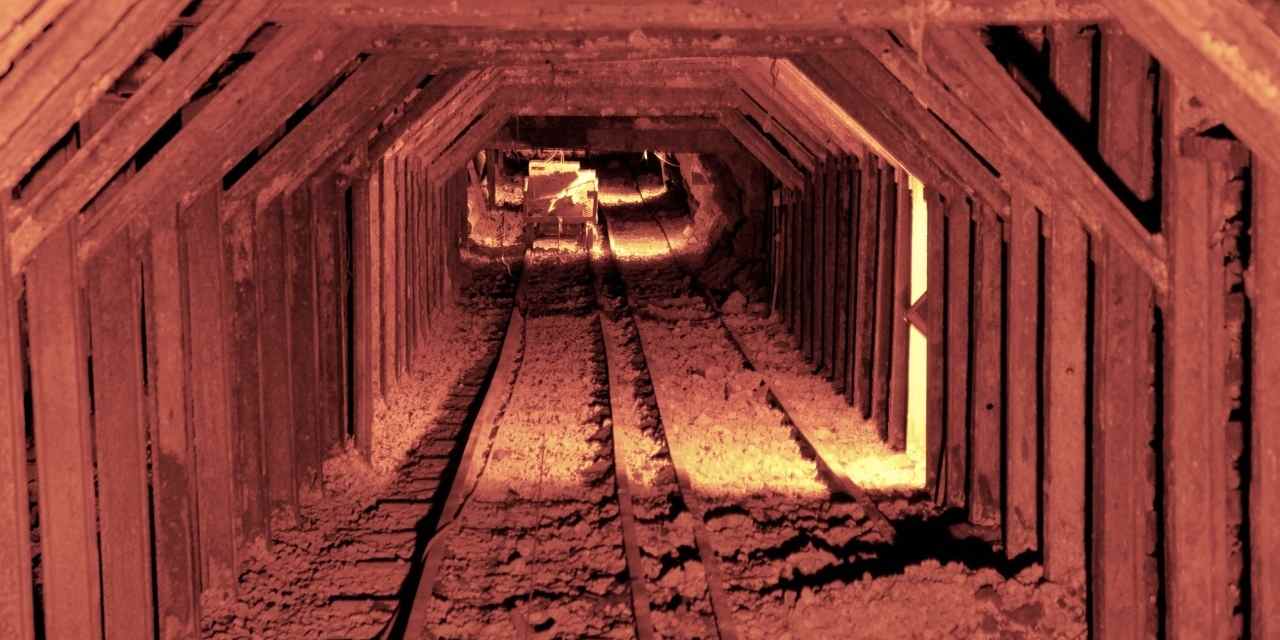
Empire Mine State Historic Park
Get a one-two punch of experiences with a visit to this remarkable site in Grass Valley, roughly 60 miles/92 kilometers northeast of Sacramento. First, spend time in the Visitor Center to learn about one of California’s oldest, largest, deepest, longest, and richest gold mines, where, in the course of a century, 5.6 million ounces/159 million grams of gold were mined—enough to fill a box 7 feet/3 meters long, 7 feet/3 meters high, and 7 feet/3 meters deep by the time the mine shut down in 1956. To get a sense of the size of the mine, see the scale model representing the mine’s 5-square-mile/13-square-km network, then walk outside to visit the entrance of the actual shaft—a tiny peak into a staggering underground maze of 367 miles/591 kilometers.
Now shift gears—mentally and physically—with a walk through the grounds of William Bowers Bourn Jr., who took over management of the mine in 1879. Bourn Cottage—a humble name for this magnificent country estate, where no expense was spared to create a two-story stone citadel patterned after the noble estates of 19th century England, complete with redwood interiors, and leaded-glass windows.
Guided tours are offered May through September. The Mine Yard Tour sheds light on the rough lives of the miners who worked here. Get the flip side on the Cottage Grounds Tour, which includes a visit to the sumptuous Bourn Cottage.
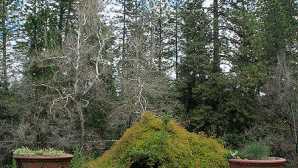
Central California
Discover gold country.

Bumping up against the west side of the Sierra Nevada Range, on California’s eastern side, the Sierra foothills that make up the Gold Country are California Classics.
Discovery of gold in 1848 sparked the largest mass migration in U.S. history, with more than 300,000 pioneers heading west.
Here, the state’s past, present, and future merge into one unforgettable destination. Pan for gold like a 49er, bike through meadow-and-oak countryside, and raft a rapid-filled river, then explore historic towns with Old West architecture and a new generation of pioneers, opening up outstanding wineries, farm-to-table restaurants, inviting shops, and charming B&Bs.
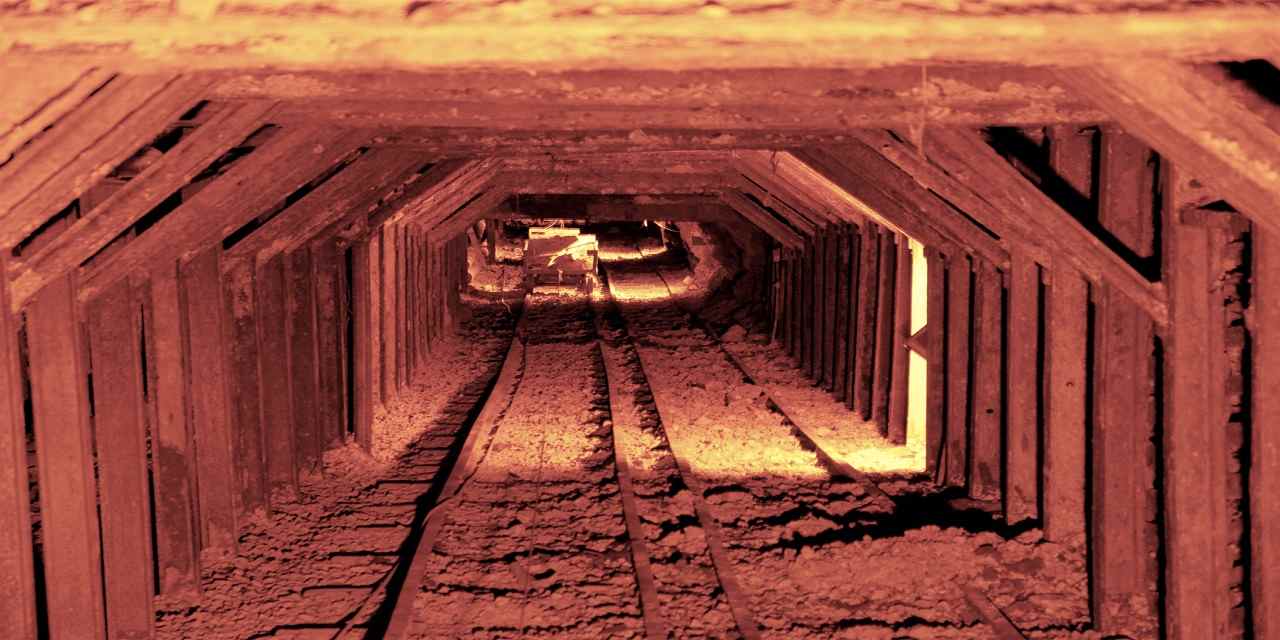
Spotlight: Sacramento
Like many cities, California’s state capitol is undergoing an energetic renaissance. Young adults looking for an urban vibe are moving into this...
Juicy heirloom tomatoes and just-picked strawberries. Super-sweet peaches shaped like mini Ufos. Artisanal cheeses, emerald-green olive oils, local wildflower honey—California’s farmers’ markets...

Back in 1854, the first California State Fair was held in San Francisco, with the cows standing on display in ...
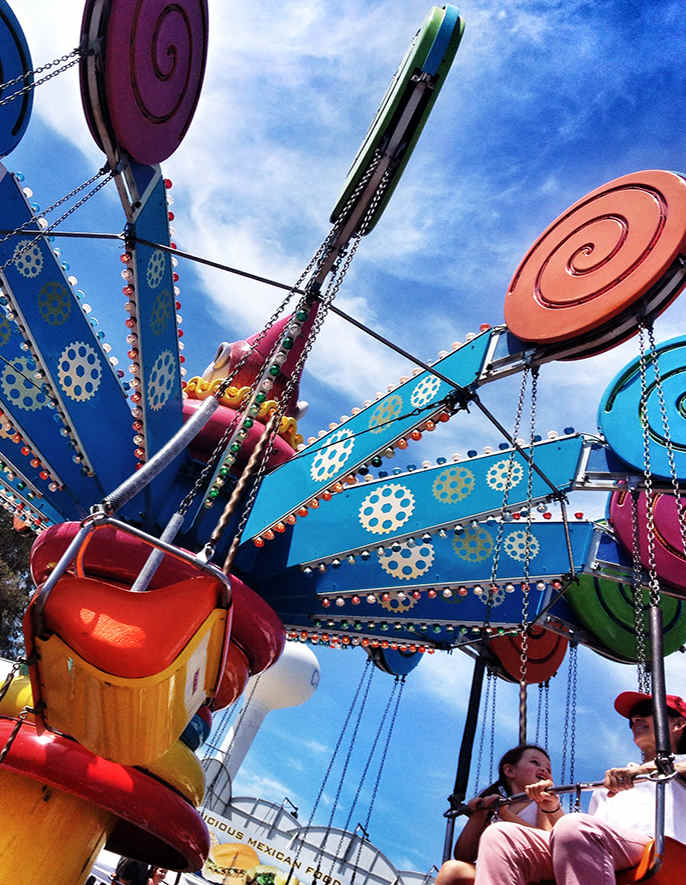
Nevada City
This forest-wrapped hamlet of handsome Victorian-era homes and tree-lined streets 60 miles north-east of...
If there was ever a box of chocolates—and all of them delicious—it’s the rich collection of natural treasures, fascinating...
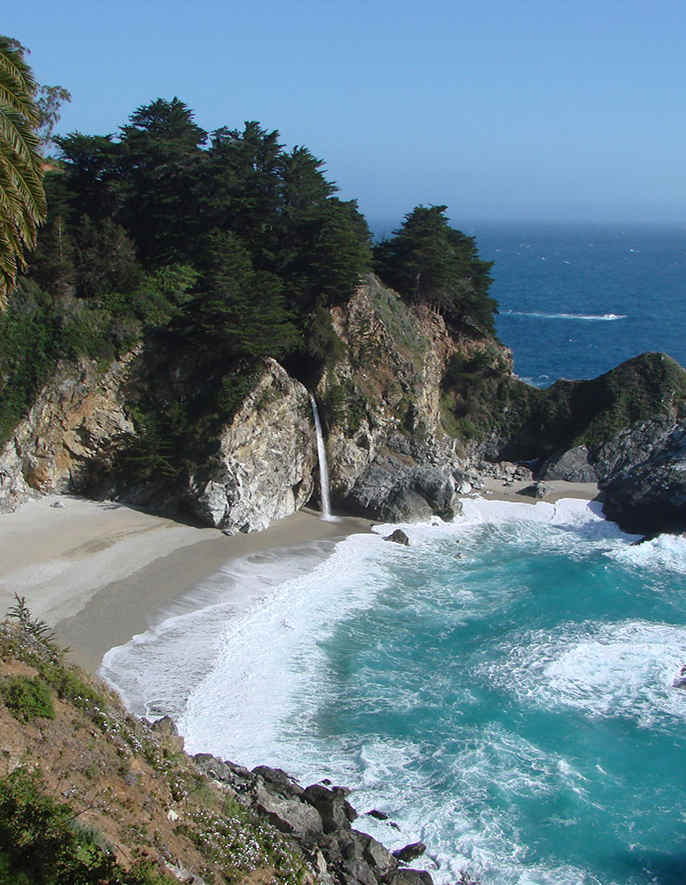
History and modern culture merge with outdoor adventure in this appealing town on the west side of the Sierra Nevada. While Auburn has long been...
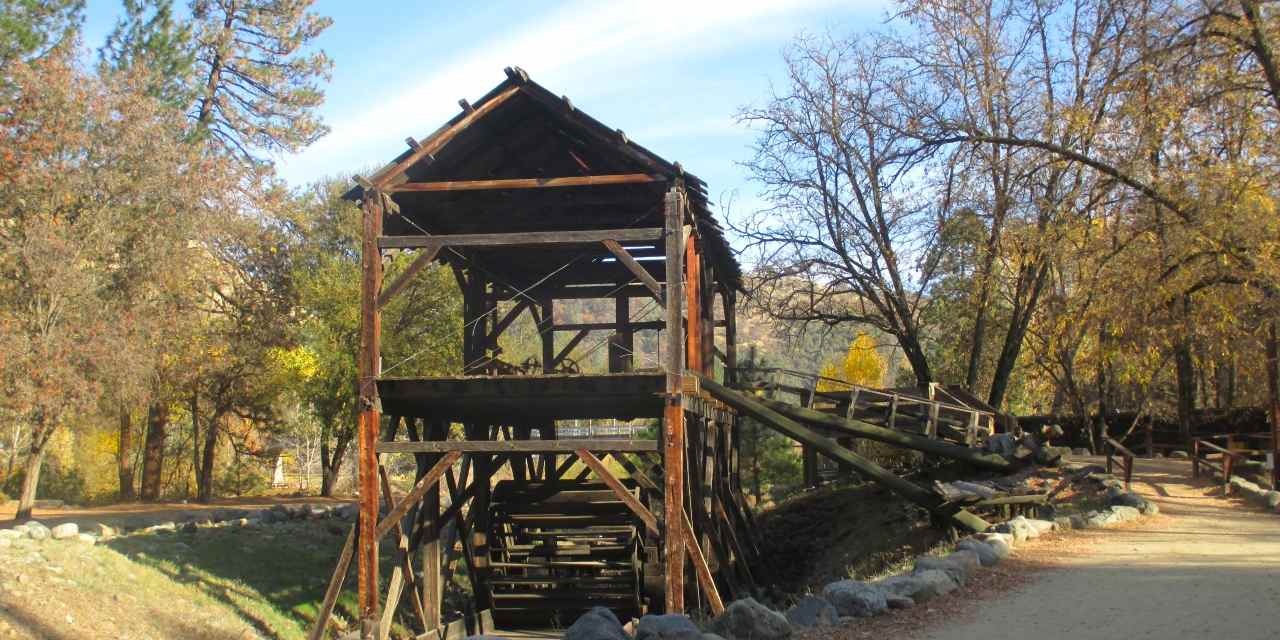
Marshall Gold Discovery
Driving the sleepy stretch of winding Highway 49 between Auburn and Placerville, it’s hard to believe the region was the booming heart of one of...
Pluck a bit of gold from a riverbed scoured by the original ’49ers. Descend deep into the earth to check out unusual rock formations. Get your heart racing with a ride down whitewater rapids. For...

The American River
The most popular whitewater-rafting river in the West, the American tumbles through the Gold Country, an inviting jumble of churning rapids, deep...
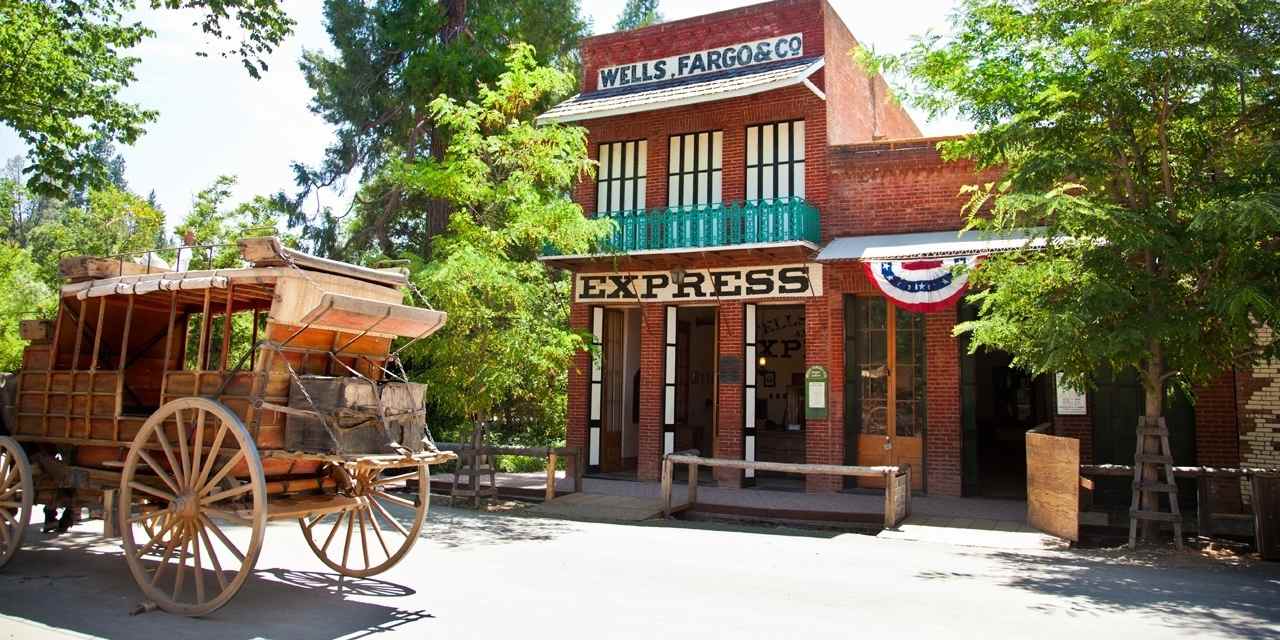
Columbia State Historic Park
With throwback charm and a treaure trove of historic artifacts, this park presents the Gold Rush in living, breathing color. Costumed ...
Elegant estates at the end of country roads lined with vineyards? Check. Low-key wineries housed in converted barns? Check again. Urban wine trails with hip in-town tasting rooms? Yup,...

Sip Wine in the Gold Country
The roots of old Zinfandel grapevines run deep in this northeastern region of California, with winemaking here dating back to the Gold Rush days...
Part frog-filled folklore, part classic country-fair fun, the annual mid-May Calaveras County Fair and Jumping Frog Jubilee stands out as...
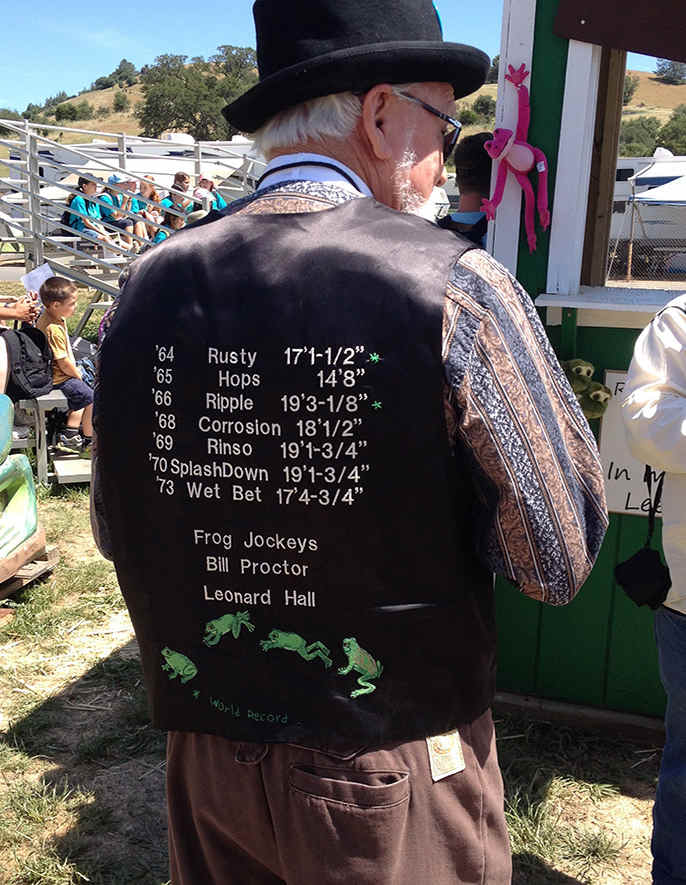
Like San Francisco in the mid-1800s, Murphys was one of California’s richest boom towns, but this appealing town in Calaveras County still feels...
“Mountains. Magic. Music.' The tagline of the Strawberry Music Festival , a lively, four-day event in May, says it all. Held at the...
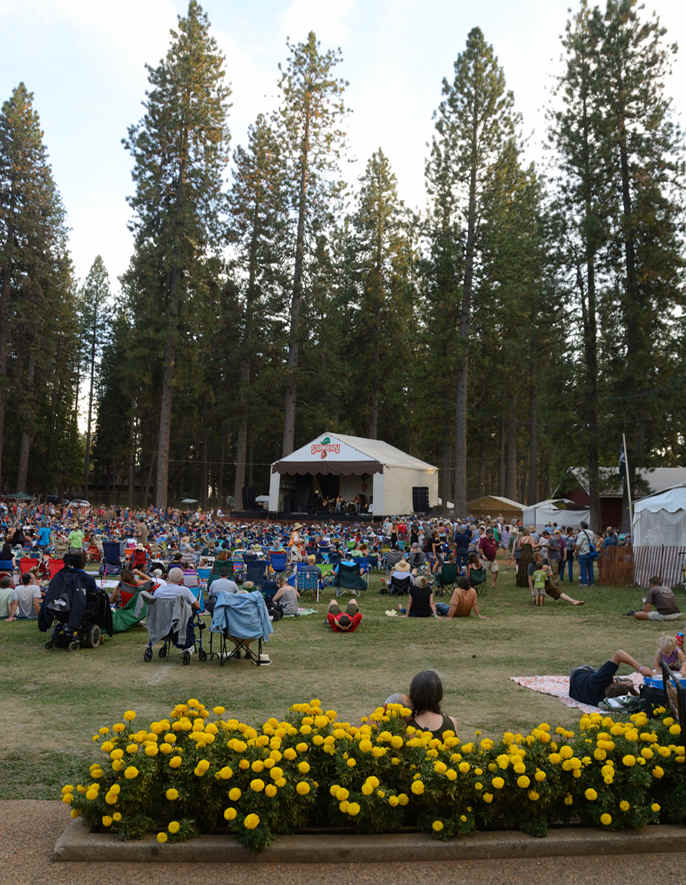
Autumn in the Gold Country means clear blue skies, fiery red grapevines, and an invigorating snap in the air. It’s apple season too, with more...
The multistage, 575-mile Amgen Tour of California is the largest cycling event in North America, and every May the course brings...
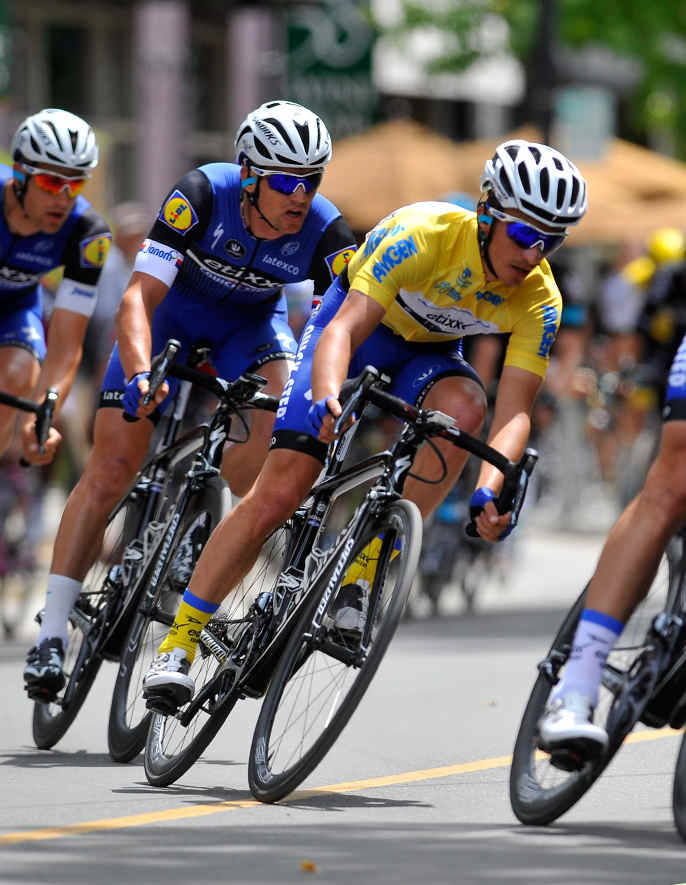
Moaning Cavern
Discovered by miners in 1851, this vertical chamber near Angels Camp is so massive it is the largest public cavern in California—big enough to...
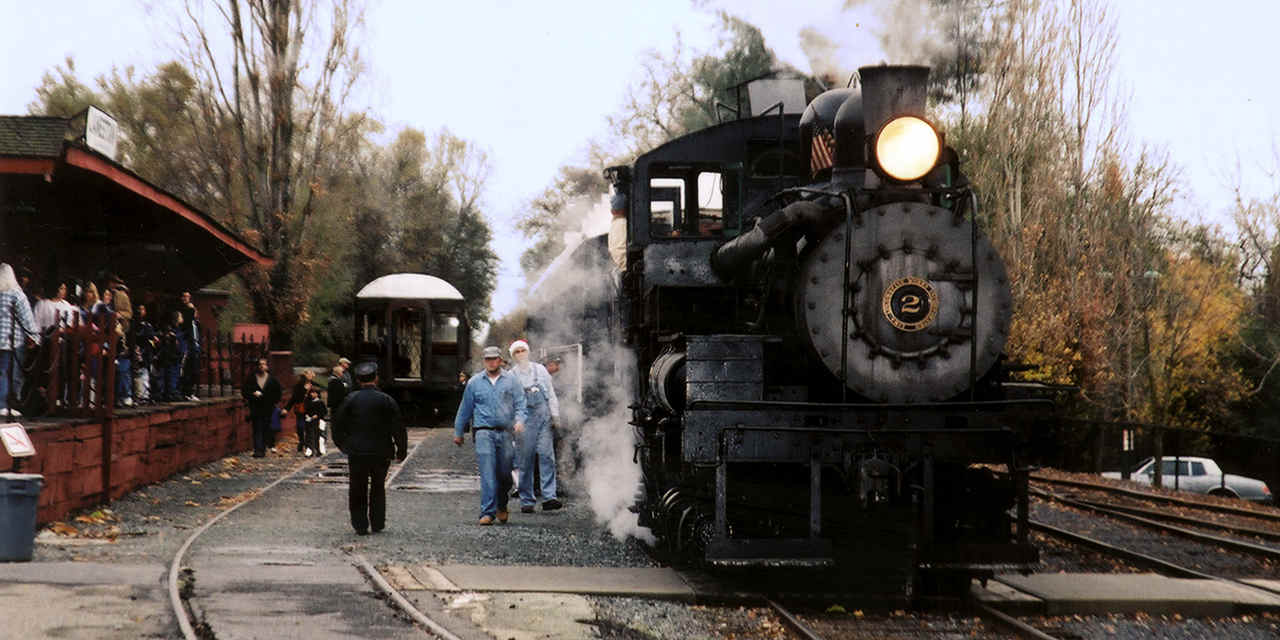
It’s unbelievable but true: you can still wade into the shallows of the South Fork of the American River and find flecks of gold, just like the...
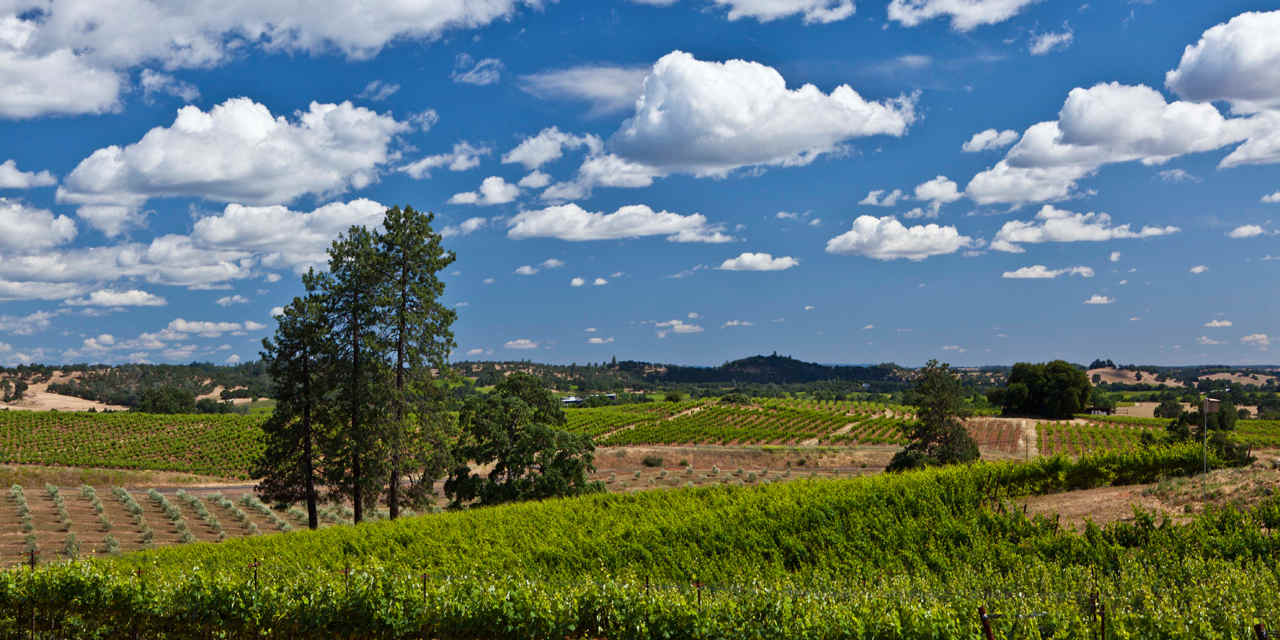
From almonds and olives up north to avocados, oranges, and dates in South, the Golden State has a crop (or 10) for nearly every stretch of terrain. After all, ...

California Welcome Centers in Gold Country
Placer County is a continent within a county because of its diversity of landscape, history and activities.
Millions of vacationers travel...

Driving the sleepy stretch of winding Highway 49 between Auburn and Placerville, it’s hard to believe the region was the booming heart of one of the most significant...
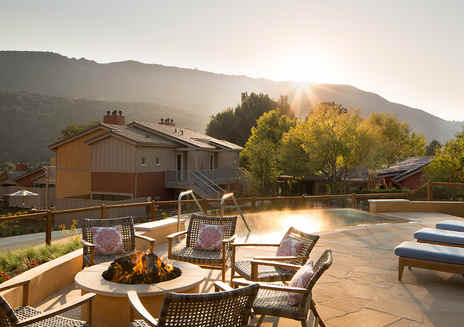
There’s a sense of place at Bernardus Lodge that’s baked into the resort. It permeates your...

Nestled high in the mountains above the beaches of Santa Cruz, Love Apple Farms is the exclusive produce provider for Michelin-starred Manresa restaurant in nearby Los...
California ditches Empire Mine tunnel tourism project in Grass Valley
In Nevada County, this 850-foot tunnel into history was supposed to be the crowning attraction for a region whose heritage is gilded with gold.
In a project 23 years in the planning, the California Department of Parks and Recreation spent $3.5 million so tourists could board ore-style carts that three 1950s battery-powered “locos” would pull deep into the legendary Empire Mine in Grass Valley. Amid the underground chill, and in a horizontal passage built in 2005 with steel beams and framing that soon rusted to an earthy brown, they were to travel into a mine whose 367 miles of deep shafts yielded 6 million ounces of gold.
Now it appears that all this heralded tourism project has yielded is a modern-day boondoggle.
State parks officials froze the project in 2012 because of concerns that corrosion in many beams threatened the structural safety; and they recently announced they will not spend more money on the project. They said it could cost $1.4 million or more to make repairs, plus untold amounts in long-term maintenance. The endeavor is now considered dead.
The outcome has left Nevada County officials and members of the Empire Mine Park Association, a volunteer group that secured a $600,000 state grant to support the project, frustrated and angry.
“When we got the word that this was being shut down, several of us had to manage our grief,” said volunteer Jim Dierberger, a retired architect and past president of the park association. “It was like a family member died. Some of us are still reeling.”
In October, the Nevada County Board of Supervisors passed a resolution urging that repairs be completed because the project would pay off in tourism with “thousands of future visitors.” They were to be drawn to underground displays, including an 1860s mining drift and grizzled-looking mannequins staged to depict miners and technologies from different eras in Empire Mine’s 106-year history.
As part of the $3.5 million in state spending, the Empire Mine Park Association used grant money from the California Cultural and Historical Endowment to build an 1880s-style visitors center and ticket office, where tourists were to pick up their hardhats, raincoats and headlamps. The volunteer group, which was to run the attraction, also used grant funds to buy the battery-powered engines from a Canadian mining company for the underground excursions and construct a building for their storage and maintenance.
But a 2012 inspection report by the state fire marshal questioned the structural integrity of steel beams, which a private contractor erected every four feet to support the horizontal tunnel, called an adit, into the mine. State parks officials put the project on hold, saying as many as one-third of the beams may have been weakened by corrosion.
It didn’t help that the project came to fruition as the state faced serious budget problems. Officials say the state parks system faces $1 billion in unattended maintenance.
Last week, chief deputy parks director Aaron Robertson said the state had no interest in moving forward. “We just did not feel it was the wisest decision to spend additional dollars on a project where we didn’t know where the end was,” he said.
In rural Nevada County, the Empire Mine State Historic Park is a major draw that brings in 110,000 visitors a year, including 60,000 paying guests. They hike miles of trails, visit the gardens and regal English manor – the Empire Cottage – of San Francisco businessman William B. Bourn Sr., whose family took control of the mine in 1869. They tour the mine head frame, machine shop, blacksmith and refinery room and climb down a small set of stairs where miners used to descend deep into the shaft in a cable-operated “man skip.”
For regional officials and park volunteers, the adit project and its underground tour into the historic workings of the mine was to be the crowning attraction.
Larry Skinner, a retired Del Monte foods executive who serves as president of the Empire Mine Parks Association, said as many as 200 local volunteers – “retired insurance people, teachers, airline pilots and salesmen” – had donated time to help make the underground tour a reality. Under supervision of parks officials, many helped install water lines, electricity and high-pressure air circulation to the adit, seeking to reduce taxpayer costs.
To the volunteers, the idea that the state parks department no longer considered the adit project worthy of its budget seemed incongruous with the legacy of a mine that produced gold worth more than $8 billion in today’s dollars. The Empire Mine association offered to spend $50,000 for an engineering study on repairing the beams and pledged a fundraising drive to help pay for the work.
Skinner argued that the bulk of the corroded beams are located in a stretch of tunnel that is solid rock with no risk of collapse. “A lot of them,” he said of the beams, “are not holding up anything but their own weight.”
Last month, Skinner fired off a searing complaint to Anthony Jackson, a retired U.S. Marine Corps general who oversees state parks, saying the department was killing the project based on “unsubstantiated and erroneous information.”
“This represents an enormous loss to not only the community and the park system, but also to the taxpayers of this state, who will have spent over $3.5 million on this inaccessible hole in the ground,” Skinner wrote, adding some italics for emphasis. “Is this really what you want us to do?”
In a Feb. 4 response, Jackson wrote that state parks across California face significant fiscal challenges and deferred maintenance costs due to years of state budget shortfalls, and that it wasn’t prudent to proceed with a project presenting “significant safety concerns.” He said parks officials had decided to stop funding the project “permanently.”
“Currently, the adit is unsafe and in need of critical repairs and ongoing maintenance,” Jackson wrote. “As stewards of the people’s state parks, the department is obligated to ensure the viability of cultural and natural resources in the entire system, as well as the public safety.”
Soon afterward, the Empire Mine Park Association put out a position paper. It declared: “The long anticipated Underground Tour at the Empire Mine State Historic Park now appears to be ‘history’ itself.”
The park association is trying to figure out whether it can salvage modest tourism benefits from the visitors’ center – where the mannequins are now packed in a closet – and the vintage-style maintenance building – where the parked “locos” and ore carts are unable to roll down the tracks into the new Empire Mine adit.
Recently, a county supervisor and park volunteers took a fraction of a tour into the tunnel that is to remain closed to the public.
“I understand there are challenges and budget priorities, but I hope we keep the door open on this,” said Nevada County Supervisor Terry Lamphier, who drafted the county resolution asking park officials to revive the project. Standing in the cool air, amid the rusted steel framing, he said: “It would be a good return for the taxpayers and very good for the local tourism economy. Never say never.”
A few dozen yards in, the delegation turned back. Due to structural concerns, state parks officials said, it wasn’t safe to venture further.
This story was originally published February 13, 2014, 12:00 AM.
Get one year of unlimited digital access for $159.99
Only 44¢ per day

Sacramento has one of the least affordable housing markets in US, report says. Here’s why
Teen arrested, staffers treated at hospital after medical incident at Northern California school
Bank in Elk Grove robbed at gunpoint, police say. Authorities seek two suspects
California legalized weed, then businesses started suffering. How federal rescheduling would help

Sacramento DA’s Office asks judge not to scale down homeless lawsuit against city
Live Nation to drop $25 concert tickets to over 5,000 shows. Who’s coming to Sacramento?

IMAGES
COMMENTS
Visit Empire Mine! Empire Mine State Historic Park is the site of one of the oldest, deepest, and richest gold mines in California. The park is in Grass Valley at 10791 East Empire Street. In operation for more than 100 years, the mine extracted 5.8 million ounces of gold before it closed in 1956. The park contains many of the mine's ...
Empire Mine's close to 850 acres are rich in history and beauty. At elevations of 2,500 to 2,900 feet, they cover a maze of 367 miles of deep mine shafts. Located in the western Sierra Nevada, 50 miles from Sacramento, Empire Mine State Historic Park remains rich in gold-mine history. Empire Mine State Historic Park welcomes around 100,000 a ...
Tour a Gold Rush mansion then go underground First, spend time in the Visitor Center to learn about one of California's oldest, largest, deepest, longest, and richest gold mines, where, in the course of a century, 5.6 million ounces/159 million grams of gold were mined—enough to fill a box 7 feet/3 meters long, 7 feet/3 meters high, and 7 ...
Get a one-two punch of experiences with a visit to the remarkable Empire Mine Historic State Park in Grass Valley, roughly 60 miles northeast of Sacramento.First, spend time in the Visitor Center to learn about one of California's oldest, largest, deepest, longest, and richest gold mines, where, in the course of a century, 5.6 million ounces of gold were mined—enough to fill a box 7 feet ...
Empire Mine State Historic Park is the site of one of the oldest, deepest, and richest gold mines in California. The park is in Grass Valley at 10791 East Empire Street. In operation for more than 100 years, the mine extracted 5.8 million ounces of gold before it closed in 1956. The park contains many of the mine's buildings, the owner's ...
Located in the beautiful Sierra Nevada foothills in the historic town of Grass Valley, the Empire Mine State Historic Park is one of the most well-preserved gold mines in the United States. Sitting on 856 acres, this mine contains 367 miles of mine tunnels and 14 miles of some amazing dog friendly hiking trails. Though.
The Empire Mine State Historic Park, located four miles southeast of Downtown Grass Valley, offers something for everyone. For those who admire beautiful buildings, the Empire Cottage, home of original mine owner, William Bourn, Junior, is sure to delight. Built in 1897 at a cost of $25,000, this English manor-style home sits amid thirteen ...
To immerse visitors in the full experience of an underground mining operation, the park is preparing a tour into an 800 ft. tunnel that joins a 1860s drift off of the main shaft of the mine.
Location: 10791 E Empire St, Grass Valley, CA 95945; Getting There. Empire Mine State Historic Park is located northeast of Sacramento in Grass Valley. It takes about an hour to drive there, and you will take Highway 80 north to Highway 174. This road winds around for about 14 miles before arriving at the park.
Empire Mine State Historic Park PARK INFO; GETTING HERE; RESERVATIONS; BROCHURES; PARK EVENTS; FEATURES; Phone Number (530) 273-8522. Park Hours. Park is open daily from 10AM - 4PM. (Winter Hours- 11/1-2/28) ... Guided Tours Interpretive Exhibits Museums
Empire Mine State Historic Park. Atop 367 miles of mine shafts tunneling almost a vertical mile beneath the surface, Gold Country's best-preserved gold-quartz-mining operation is worth a solid half-day's exploration. From 1850 to 1956 the miners here, mostly Cornish, produced 5.8 million troy ounces of gold (worth about $8 billion today ...
Empire Mine State Historic Park. / 39.20361°N 121.04278°W / 39.20361; -121.04278. Empire Mine State Historic Park is a state-protected mine and park in the Sierra Nevada mountains in Grass Valley, California, U.S. The Empire Mine is on the National Register of Historic Places, a federal Historic District, and a California Historical ...
Empire Mine State Historic Park is the site of one of the oldest, largest, deepest, longest and richest gold mines in the state of California. In operation for more than 100 years, the gold mine produced 5.6 million ounces of gold (more than eight billion dollars worth by today's standards) before it closed in 1956.
The true "Gold" is the Empire Mine grounds, California State Parks, Rangers, and the wonderful docents. ... Unfortunately, there is no underground mine tour. But the visitors' center and park grounds are well worth a look. I particularly enjoy the cottage tour, which includes a limited look inside the mine-owner's 4600 square foot "cottage ...
10791 Empire Mine St. Grass Valley, CA. 530-273-8522. Photo credit: Peggy & Howard Levine. Owners of the Swan Levine House Bed & Breakfast in Grass Valley. www.swanlevinehouse.com. Truly in the Heart of the Mother Lode. The Department of Parks & Recreation is close to realizing the Empire Mine's Underground Tour Project.
The Empire Mine State Historic Park was opened, which soon became a popular tourist destination. The main attractions are historical tours of the Bourn Cottage, the mine yard, and the Park museum. The museum shows a scale model of the underground workings of the Empire/Star mine complex. A gold room displays ore samples from local mines. There ...
Underground Tours. The park plans to offer underground tours in early April 2012. Construction has begun so visitors will soon be able to go 800 feet down and see what it was like to mine for gold ...
The mine and park are state-protected sites. The park's museum contains a scale model of the underground workings of the Empire/Star mine complex, exhibits of ore samples from local mines, a recreated Assay Office and a collection of minerals. There are also 13 acres of scenic gardens to tour.
Empire Mine State Historic Park is the site of one of the oldest, deepest, and richest gold mines in California. In operation for more than 100 years, the mine extracted 5.8 million ounces of gold before it closed in 1956. The park contains many of the mine's buildings, the owner's home and restored gardens, as well as the entrance to the ...
More than 5 million ounces of gold (worth well over seven billion dollars today) were taken from the Empire Mine—estimated to be only 20% of the total gold deposits still buried under the park (and underwater). In 1929 Bourn sold the mine to the Newmont Mining Corporation, which controlled the Empire Mine until its closure in 1957.
Empire Mine's close to 850 acres are rich in history and beauty. At elevations of 2,500 to 2,900 feet, they cover a maze of 367 miles of deep mine shafts. Located in the western Sierra Nevada, 50 miles from Sacramento, Empire Mine State Historic Park remains rich in gold-mine history. Key dates in Empire Mine's unique history
Get a one-two punch of experiences with a visit to this remarkable site in Grass Valley, roughly 60 miles/92 kilometers northeast of Sacramento. First, spend time in the Visitor Center to learn about one of California's oldest, largest, deepest, longest, and richest gold mines, where, in the course of a century, 5.6 million ounces/159 million grams of gold were mined—enough to fill a box 7 ...
They were to be drawn to underground displays, including an 1860s mining drift and grizzled-looking mannequins staged to depict miners and technologies from different eras in Empire Mine's 106 ...